- How to Cite
- Language & Lit
- Rhyme & Rhythm
- The Rewrite
- Search Glass

What is a Comparative Essay?
Paraphrasing the thesis statement, the author's opinion, scope of conclusion, how to write a conclusion for a compare & contrast essay.
A well-written essay should have at least three main components: an introduction, a body and a conclusion. While the introduction introduces the topic and draws the reader in, the body of the essay should consist of several paragraphs supporting the essay's main argument or hypothesis. A strong conclusion will satisfactorily draw an essay's argument to a close. For a comparative essay, the conclusion should successfully paraphrase the main points in the essay and offer a closing thought or opinion.
A compare and contrast essay, also known as a comparison essay, talks about how two ideas or objects differ and how they are similar. Some essays may only talk about similarities, while others may only talk about differences. This focus depends on the length and scope of the essay.
An example of a topic for a compare and contrast essay is a comparison between life in a city and life in the country. The conclusion to this essay will include at least two important components: the paraphrased thesis and the author's opinion.
The thesis statement is usually included in the introduction to the essay, and it provides the reader with a clear understanding of the essay's topic and scope. The first or second sentence of the conclusion should be a restatement, or paraphrase, of the thesis statement.
Example:
If the thesis statement is, "Many people prefer to live in a city because of access to better health care and a wider variety of cultural and athletic events," the paraphrased thesis statement could be, "In conclusion, many people find city life preferable because of closer proximity to more cutting-edge healthcare systems and because of more choices of extra-curricular activities."
While the body of the essay should generally include objective information, the conclusion should include one or two sentences articulating the author's opinion. This stance should not be conveyed using an "I" statement, which is usually not recommended in formal writing.
A sentence relating to the thesis statement comparing life in the city versus life in the country could be, "For these reasons mentioned above and others, life in the city is more advisable for individuals for whom a better quality of life is non-negotiable."
The conclusion should not include more than a re-stated thesis statement and the author's short opinion. This section of the essay is not a place in which new information or information unrelated to the topic is introduced. All information should be contained within the introduction and the body of the essay, and the conclusion's scope should be limited to what has already been mentioned in the essay. Oftentimes, the conclusion will end with the author's opinion.
Megan Ritchie has been a writer for more than 10 years, and has been published in a number of journals and newspapers, including "The Daily Targum" (Rutgers University's daily newspaper) and "The Philadelphia Inquirer." She has a Master's degree in Education from the University of Pennsylvania.
Comparative Essay
How to Write a Comparative Essay – A Complete Guide
10 min read

People also read
Learn How to Write an Editorial on Any Topic
Best Tips on How to Avoid Plagiarism
How to Write a Movie Review - Guide & Examples
A Complete Guide on How to Write a Summary for Students
Write Opinion Essay Like a Pro: A Detailed Guide
Evaluation Essay - Definition, Examples, and Writing Tips
How to Write a Thematic Statement - Tips & Examples
How to Write a Bio - Quick Tips, Structure & Examples
How to Write a Synopsis – A Simple Format & Guide
Visual Analysis Essay - A Writing Guide with Format & Sample
List of Common Social Issues Around the World
Writing Character Analysis - Outline, Steps, and Examples
11 Common Types of Plagiarism Explained Through Examples
Article Review Writing: A Complete Step-by-Step Guide with Examples
A Detailed Guide on How to Write a Poem Step by Step
Detailed Guide on Appendix Writing: With Tips and Examples
Comparative essay is a common assignment for school and college students. Many students are not aware of the complexities of crafting a strong comparative essay.
If you too are struggling with this, don't worry!
In this blog, you will get a complete writing guide for comparative essay writing. From structuring formats to creative topics, this guide has it all.
So, keep reading!
- 1. What is a Comparative Essay?
- 2. Comparative Essay Structure
- 3. How to Start a Comparative Essay?
- 4. How to Write a Comparative Essay?
- 5. Comparative Essay Examples
- 6. Comparative Essay Topics
- 7. Tips for Writing A Good Comparative Essay
- 8. Transition Words For Comparative Essays
What is a Comparative Essay?
A comparative essay is a type of essay in which an essay writer compares at least two or more items. The author compares two subjects with the same relation in terms of similarities and differences depending on the assignment.
The main purpose of the comparative essay is to:
- Highlight the similarities and differences in a systematic manner.
- Provide great clarity of the subject to the readers.
- Analyze two things and describe their advantages and drawbacks.
A comparative essay is also known as compare and contrast essay or a comparison essay. It analyzes two subjects by either comparing them, contrasting them, or both. The Venn diagram is the best tool for writing a paper about the comparison between two subjects.
Moreover, a comparative analysis essay discusses the similarities and differences of themes, items, events, views, places, concepts, etc. For example, you can compare two different novels (e.g., The Adventures of Huckleberry Finn and The Red Badge of Courage).
However, a comparative essay is not limited to specific topics. It covers almost every topic or subject with some relation.
Comparative Essay Structure
A good comparative essay is based on how well you structure your essay. It helps the reader to understand your essay better.
The structure is more important than what you write. This is because it is necessary to organize your essay so that the reader can easily go through the comparisons made in an essay.
The following are the two main methods in which you can organize your comparative essay.
Point-by-Point Method
The point-by-point or alternating method provides a detailed overview of the items that you are comparing. In this method, organize items in terms of similarities and differences.
This method makes the writing phase easy for the writer to handle two completely different essay subjects. It is highly recommended where some depth and detail are required.
Below given is the structure of the point-by-point method.
Block Method
The block method is the easiest as compared to the point-by-point method. In this method, you divide the information in terms of parameters. It means that the first paragraph compares the first subject and all their items, then the second one compares the second, and so on.
However, make sure that you write the subject in the same order. This method is best for lengthy essays and complicated subjects.
Here is the structure of the block method.
Therefore, keep these methods in mind and choose the one according to the chosen subject.
Mixed Paragraphs Method
In this method, one paragraph explains one aspect of the subject. As a writer, you will handle one point at a time and one by one. This method is quite beneficial as it allows you to give equal weightage to each subject and help the readers identify the point of comparison easily.
How to Start a Comparative Essay?
Here, we have gathered some steps that you should follow to start a well-written comparative essay.
Choose a Topic
The foremost step in writing a comparative essay is to choose a suitable topic.
Choose a topic or theme that is interesting to write about and appeals to the reader.
An interesting essay topic motivates the reader to know about the subject. Also, try to avoid complicated topics for your comparative essay.
Develop a List of Similarities and Differences
Create a list of similarities and differences between two subjects that you want to include in the essay. Moreover, this list helps you decide the basis of your comparison by constructing your initial plan.
Evaluate the list and establish your argument and thesis statement .
Establish the Basis for Comparison
The basis for comparison is the ground for you to compare the subjects. In most cases, it is assigned to you, so check your assignment or prompt.
Furthermore, the main goal of the comparison essay is to inform the reader of something interesting. It means that your subject must be unique to make your argument interesting.
Do the Research
In this step, you have to gather information for your subject. If your comparative essay is about social issues, historical events, or science-related topics, you must do in-depth research.
However, make sure that you gather data from credible sources and cite them properly in the essay.
Create an Outline
An essay outline serves as a roadmap for your essay, organizing key elements into a structured format.
With your topic, list of comparisons, basis for comparison, and research in hand, the next step is to create a comprehensive outline.
Here is a standard comparative essay outline:
How to Write a Comparative Essay?
Now that you have the basic information organized in an outline, you can get started on the writing process.
Here are the essential parts of a comparative essay:
Comparative Essay Introduction
Start off by grabbing your reader's attention in the introduction . Use something catchy, like a quote, question, or interesting fact about your subjects.
Then, give a quick background so your reader knows what's going on.
The most important part is your thesis statement, where you state the main argument , the basis for comparison, and why the comparison is significant.
This is what a typical thesis statement for a comparative essay looks like:
Comparative Essay Body Paragraphs
The body paragraphs are where you really get into the details of your subjects. Each paragraph should focus on one thing you're comparing.
Start by talking about the first point of comparison. Then, go on to the next points. Make sure to talk about two to three differences to give a good picture.
After that, switch gears and talk about the things they have in common. Just like you discussed three differences, try to cover three similarities.
This way, your essay stays balanced and fair. This approach helps your reader understand both the ways your subjects are different and the ways they are similar. Keep it simple and clear for a strong essay.
Comparative Essay Conclusion
In your conclusion , bring together the key insights from your analysis to create a strong and impactful closing.
Consider the broader context or implications of the subjects' differences and similarities. What do these insights reveal about the broader themes or ideas you're exploring?
Discuss the broader implications of these findings and restate your thesis. Avoid introducing new information and end with a thought-provoking statement that leaves a lasting impression.
Below is the detailed comparative essay template format for you to understand better.
Comparative Essay Format
Comparative Essay Examples
Have a look at these comparative essay examples pdf to get an idea of the perfect essay.
Comparative Essay on Summer and Winter
Comparative Essay on Books vs. Movies
Comparative Essay Sample
Comparative Essay Thesis Example
Comparative Essay on Football vs Cricket
Comparative Essay on Pet and Wild Animals
Comparative Essay Topics
Comparative essay topics are not very difficult or complex. Check this list of essay topics and pick the one that you want to write about.
- How do education and employment compare?
- Living in a big city or staying in a village.
- The school principal or college dean.
- New Year vs. Christmas celebration.
- Dried Fruit vs. Fresh. Which is better?
- Similarities between philosophy and religion.
- British colonization and Spanish colonization.
- Nuclear power for peace or war?
- Bacteria or viruses.
- Fast food vs. homemade food.
Tips for Writing A Good Comparative Essay
Writing a compelling comparative essay requires thoughtful consideration and strategic planning. Here are some valuable tips to enhance the quality of your comparative essay:
- Clearly define what you're comparing, like themes or characters.
- Plan your essay structure using methods like point-by-point or block paragraphs.
- Craft an introduction that introduces subjects and states your purpose.
- Ensure an equal discussion of both similarities and differences.
- Use linking words for seamless transitions between paragraphs.
- Gather credible information for depth and authenticity.
- Use clear and simple language, avoiding unnecessary jargon.
- Dedicate each paragraph to a specific point of comparison.
- Summarize key points, restate the thesis, and emphasize significance.
- Thoroughly check for clarity, coherence, and correct any errors.
Transition Words For Comparative Essays
Transition words are crucial for guiding your reader through the comparative analysis. They help establish connections between ideas and ensure a smooth flow in your essay.
Here are some transition words and phrases to improve the flow of your comparative essay:
Transition Words for Similarities
- Correspondingly
- In the same vein
- In like manner
- In a similar fashion
- In tandem with
Transition Words for Differences
- On the contrary
- In contrast
- Nevertheless
- In spite of
- Notwithstanding
- On the flip side
- In contradistinction
Check out this blog listing more transition words that you can use to enhance your essay’s coherence!
In conclusion, now that you have the important steps and helpful tips to write a good comparative essay, you can start working on your own essay.
However, if you find it tough to begin, you can always hire our professional essay writing service .
Our skilled writers can handle any type of essay or assignment you need. So, don't wait—place your order now and make your academic journey easier!
Frequently Asked Question
How long is a comparative essay.
A comparative essay is 4-5 pages long, but it depends on your chosen idea and topic.
How do you end a comparative essay?
Here are some tips that will help you to end the comparative essay.
- Restate the thesis statement
- Wrap up the entire essay
- Highlight the main points

Write Essay Within 60 Seconds!

Dr. Barbara is a highly experienced writer and author who holds a Ph.D. degree in public health from an Ivy League school. She has worked in the medical field for many years, conducting extensive research on various health topics. Her writing has been featured in several top-tier publications.

Paper Due? Why Suffer? That’s our Job!
Keep reading


Comparing and Contrasting
What this handout is about.
This handout will help you first to determine whether a particular assignment is asking for comparison/contrast and then to generate a list of similarities and differences, decide which similarities and differences to focus on, and organize your paper so that it will be clear and effective. It will also explain how you can (and why you should) develop a thesis that goes beyond “Thing A and Thing B are similar in many ways but different in others.”
Introduction
In your career as a student, you’ll encounter many different kinds of writing assignments, each with its own requirements. One of the most common is the comparison/contrast essay, in which you focus on the ways in which certain things or ideas—usually two of them—are similar to (this is the comparison) and/or different from (this is the contrast) one another. By assigning such essays, your instructors are encouraging you to make connections between texts or ideas, engage in critical thinking, and go beyond mere description or summary to generate interesting analysis: when you reflect on similarities and differences, you gain a deeper understanding of the items you are comparing, their relationship to each other, and what is most important about them.
Recognizing comparison/contrast in assignments
Some assignments use words—like compare, contrast, similarities, and differences—that make it easy for you to see that they are asking you to compare and/or contrast. Here are a few hypothetical examples:
- Compare and contrast Frye’s and Bartky’s accounts of oppression.
- Compare WWI to WWII, identifying similarities in the causes, development, and outcomes of the wars.
- Contrast Wordsworth and Coleridge; what are the major differences in their poetry?
Notice that some topics ask only for comparison, others only for contrast, and others for both.
But it’s not always so easy to tell whether an assignment is asking you to include comparison/contrast. And in some cases, comparison/contrast is only part of the essay—you begin by comparing and/or contrasting two or more things and then use what you’ve learned to construct an argument or evaluation. Consider these examples, noticing the language that is used to ask for the comparison/contrast and whether the comparison/contrast is only one part of a larger assignment:
- Choose a particular idea or theme, such as romantic love, death, or nature, and consider how it is treated in two Romantic poems.
- How do the different authors we have studied so far define and describe oppression?
- Compare Frye’s and Bartky’s accounts of oppression. What does each imply about women’s collusion in their own oppression? Which is more accurate?
- In the texts we’ve studied, soldiers who served in different wars offer differing accounts of their experiences and feelings both during and after the fighting. What commonalities are there in these accounts? What factors do you think are responsible for their differences?
You may want to check out our handout on understanding assignments for additional tips.
Using comparison/contrast for all kinds of writing projects
Sometimes you may want to use comparison/contrast techniques in your own pre-writing work to get ideas that you can later use for an argument, even if comparison/contrast isn’t an official requirement for the paper you’re writing. For example, if you wanted to argue that Frye’s account of oppression is better than both de Beauvoir’s and Bartky’s, comparing and contrasting the main arguments of those three authors might help you construct your evaluation—even though the topic may not have asked for comparison/contrast and the lists of similarities and differences you generate may not appear anywhere in the final draft of your paper.
Discovering similarities and differences
Making a Venn diagram or a chart can help you quickly and efficiently compare and contrast two or more things or ideas. To make a Venn diagram, simply draw some overlapping circles, one circle for each item you’re considering. In the central area where they overlap, list the traits the two items have in common. Assign each one of the areas that doesn’t overlap; in those areas, you can list the traits that make the things different. Here’s a very simple example, using two pizza places:

To make a chart, figure out what criteria you want to focus on in comparing the items. Along the left side of the page, list each of the criteria. Across the top, list the names of the items. You should then have a box per item for each criterion; you can fill the boxes in and then survey what you’ve discovered.
Here’s an example, this time using three pizza places:
As you generate points of comparison, consider the purpose and content of the assignment and the focus of the class. What do you think the professor wants you to learn by doing this comparison/contrast? How does it fit with what you have been studying so far and with the other assignments in the course? Are there any clues about what to focus on in the assignment itself?
Here are some general questions about different types of things you might have to compare. These are by no means complete or definitive lists; they’re just here to give you some ideas—you can generate your own questions for these and other types of comparison. You may want to begin by using the questions reporters traditionally ask: Who? What? Where? When? Why? How? If you’re talking about objects, you might also consider general properties like size, shape, color, sound, weight, taste, texture, smell, number, duration, and location.
Two historical periods or events
- When did they occur—do you know the date(s) and duration? What happened or changed during each? Why are they significant?
- What kinds of work did people do? What kinds of relationships did they have? What did they value?
- What kinds of governments were there? Who were important people involved?
- What caused events in these periods, and what consequences did they have later on?
Two ideas or theories
- What are they about?
- Did they originate at some particular time?
- Who created them? Who uses or defends them?
- What is the central focus, claim, or goal of each? What conclusions do they offer?
- How are they applied to situations/people/things/etc.?
- Which seems more plausible to you, and why? How broad is their scope?
- What kind of evidence is usually offered for them?
Two pieces of writing or art
- What are their titles? What do they describe or depict?
- What is their tone or mood? What is their form?
- Who created them? When were they created? Why do you think they were created as they were? What themes do they address?
- Do you think one is of higher quality or greater merit than the other(s)—and if so, why?
- For writing: what plot, characterization, setting, theme, tone, and type of narration are used?
- Where are they from? How old are they? What is the gender, race, class, etc. of each?
- What, if anything, are they known for? Do they have any relationship to each other?
- What are they like? What did/do they do? What do they believe? Why are they interesting?
- What stands out most about each of them?
Deciding what to focus on
By now you have probably generated a huge list of similarities and differences—congratulations! Next you must decide which of them are interesting, important, and relevant enough to be included in your paper. Ask yourself these questions:
- What’s relevant to the assignment?
- What’s relevant to the course?
- What’s interesting and informative?
- What matters to the argument you are going to make?
- What’s basic or central (and needs to be mentioned even if obvious)?
- Overall, what’s more important—the similarities or the differences?
Suppose that you are writing a paper comparing two novels. For most literature classes, the fact that they both use Caslon type (a kind of typeface, like the fonts you may use in your writing) is not going to be relevant, nor is the fact that one of them has a few illustrations and the other has none; literature classes are more likely to focus on subjects like characterization, plot, setting, the writer’s style and intentions, language, central themes, and so forth. However, if you were writing a paper for a class on typesetting or on how illustrations are used to enhance novels, the typeface and presence or absence of illustrations might be absolutely critical to include in your final paper.
Sometimes a particular point of comparison or contrast might be relevant but not terribly revealing or interesting. For example, if you are writing a paper about Wordsworth’s “Tintern Abbey” and Coleridge’s “Frost at Midnight,” pointing out that they both have nature as a central theme is relevant (comparisons of poetry often talk about themes) but not terribly interesting; your class has probably already had many discussions about the Romantic poets’ fondness for nature. Talking about the different ways nature is depicted or the different aspects of nature that are emphasized might be more interesting and show a more sophisticated understanding of the poems.
Your thesis
The thesis of your comparison/contrast paper is very important: it can help you create a focused argument and give your reader a road map so they don’t get lost in the sea of points you are about to make. As in any paper, you will want to replace vague reports of your general topic (for example, “This paper will compare and contrast two pizza places,” or “Pepper’s and Amante are similar in some ways and different in others,” or “Pepper’s and Amante are similar in many ways, but they have one major difference”) with something more detailed and specific. For example, you might say, “Pepper’s and Amante have similar prices and ingredients, but their atmospheres and willingness to deliver set them apart.”
Be careful, though—although this thesis is fairly specific and does propose a simple argument (that atmosphere and delivery make the two pizza places different), your instructor will often be looking for a bit more analysis. In this case, the obvious question is “So what? Why should anyone care that Pepper’s and Amante are different in this way?” One might also wonder why the writer chose those two particular pizza places to compare—why not Papa John’s, Dominos, or Pizza Hut? Again, thinking about the context the class provides may help you answer such questions and make a stronger argument. Here’s a revision of the thesis mentioned earlier:
Pepper’s and Amante both offer a greater variety of ingredients than other Chapel Hill/Carrboro pizza places (and than any of the national chains), but the funky, lively atmosphere at Pepper’s makes it a better place to give visiting friends and family a taste of local culture.
You may find our handout on constructing thesis statements useful at this stage.
Organizing your paper
There are many different ways to organize a comparison/contrast essay. Here are two:
Subject-by-subject
Begin by saying everything you have to say about the first subject you are discussing, then move on and make all the points you want to make about the second subject (and after that, the third, and so on, if you’re comparing/contrasting more than two things). If the paper is short, you might be able to fit all of your points about each item into a single paragraph, but it’s more likely that you’d have several paragraphs per item. Using our pizza place comparison/contrast as an example, after the introduction, you might have a paragraph about the ingredients available at Pepper’s, a paragraph about its location, and a paragraph about its ambience. Then you’d have three similar paragraphs about Amante, followed by your conclusion.
The danger of this subject-by-subject organization is that your paper will simply be a list of points: a certain number of points (in my example, three) about one subject, then a certain number of points about another. This is usually not what college instructors are looking for in a paper—generally they want you to compare or contrast two or more things very directly, rather than just listing the traits the things have and leaving it up to the reader to reflect on how those traits are similar or different and why those similarities or differences matter. Thus, if you use the subject-by-subject form, you will probably want to have a very strong, analytical thesis and at least one body paragraph that ties all of your different points together.
A subject-by-subject structure can be a logical choice if you are writing what is sometimes called a “lens” comparison, in which you use one subject or item (which isn’t really your main topic) to better understand another item (which is). For example, you might be asked to compare a poem you’ve already covered thoroughly in class with one you are reading on your own. It might make sense to give a brief summary of your main ideas about the first poem (this would be your first subject, the “lens”), and then spend most of your paper discussing how those points are similar to or different from your ideas about the second.
Point-by-point
Rather than addressing things one subject at a time, you may wish to talk about one point of comparison at a time. There are two main ways this might play out, depending on how much you have to say about each of the things you are comparing. If you have just a little, you might, in a single paragraph, discuss how a certain point of comparison/contrast relates to all the items you are discussing. For example, I might describe, in one paragraph, what the prices are like at both Pepper’s and Amante; in the next paragraph, I might compare the ingredients available; in a third, I might contrast the atmospheres of the two restaurants.
If I had a bit more to say about the items I was comparing/contrasting, I might devote a whole paragraph to how each point relates to each item. For example, I might have a whole paragraph about the clientele at Pepper’s, followed by a whole paragraph about the clientele at Amante; then I would move on and do two more paragraphs discussing my next point of comparison/contrast—like the ingredients available at each restaurant.
There are no hard and fast rules about organizing a comparison/contrast paper, of course. Just be sure that your reader can easily tell what’s going on! Be aware, too, of the placement of your different points. If you are writing a comparison/contrast in service of an argument, keep in mind that the last point you make is the one you are leaving your reader with. For example, if I am trying to argue that Amante is better than Pepper’s, I should end with a contrast that leaves Amante sounding good, rather than with a point of comparison that I have to admit makes Pepper’s look better. If you’ve decided that the differences between the items you’re comparing/contrasting are most important, you’ll want to end with the differences—and vice versa, if the similarities seem most important to you.
Our handout on organization can help you write good topic sentences and transitions and make sure that you have a good overall structure in place for your paper.
Cue words and other tips
To help your reader keep track of where you are in the comparison/contrast, you’ll want to be sure that your transitions and topic sentences are especially strong. Your thesis should already have given the reader an idea of the points you’ll be making and the organization you’ll be using, but you can help them out with some extra cues. The following words may be helpful to you in signaling your intentions:
- like, similar to, also, unlike, similarly, in the same way, likewise, again, compared to, in contrast, in like manner, contrasted with, on the contrary, however, although, yet, even though, still, but, nevertheless, conversely, at the same time, regardless, despite, while, on the one hand … on the other hand.
For example, you might have a topic sentence like one of these:
- Compared to Pepper’s, Amante is quiet.
- Like Amante, Pepper’s offers fresh garlic as a topping.
- Despite their different locations (downtown Chapel Hill and downtown Carrboro), Pepper’s and Amante are both fairly easy to get to.
You may reproduce it for non-commercial use if you use the entire handout and attribute the source: The Writing Center, University of North Carolina at Chapel Hill
Make a Gift
- Generating Ideas
- Drafting and Revision
- Sources and Evidence
- Style and Grammar
- Specific to Creative Arts
- Specific to Humanities
- Specific to Sciences
- Specific to Social Sciences
- CVs, Résumés and Cover Letters
- Graduate School Applications
- Other Resources
- Hiatt Career Center
- University Writing Center
- Classroom Materials
- Course and Assignment Design
- UWP Instructor Resources
- Writing Intensive Requirement
- Criteria and Learning Goals
- Course Application for Instructors
- What to Know about UWS
- Teaching Resources for WI
- FAQ for Instructors
- FAQ for Students
- Journals on Writing Research and Pedagogy
- University Writing Program
- Degree Programs
- Majors and Minors
- Graduate Programs
- The Brandeis Core
- School of Arts and Sciences
- Brandeis Online
- Brandeis International Business School
- Graduate School of Arts and Sciences
- Heller School for Social Policy and Management
- Rabb School of Continuing Studies
- Precollege Programs
- Faculty and Researcher Directory
- Brandeis Library
- Academic Calendar
- Undergraduate Admissions
- Summer School
- Financial Aid
- Research that Matters
- Resources for Researchers
- Brandeis Researchers in the News
- Provost Research Grants
- Recent Awards
- Faculty Research
- Student Research
- Centers and Institutes
- Office of the Vice Provost for Research
- Office of the Provost
- Housing/Community Living
- Campus Calendar
- Student Engagement
- Clubs and Organizations
- Community Service
- Dean of Students Office
- Orientation
- Spiritual Life
- Graduate Student Affairs
- Directory of Campus Contacts
- Division of Creative Arts
- Brandeis Arts Engagement
- Rose Art Museum
- Bernstein Festival of the Creative Arts
- Theater Arts Productions
- Brandeis Concert Series
- Public Sculpture at Brandeis
- Women's Studies Research Center
- Creative Arts Award
- Our Jewish Roots
- The Framework for the Future
- Mission and Diversity Statements
- Distinguished Faculty
- Nobel Prize 2017
- Notable Alumni
- Administration
- Working at Brandeis
- Commencement
- Offices Directory
- Faculty & Staff
- Alumni & Friends
- Parents & Families
- 75th Anniversary
- New Students
- Shuttle Schedules
- Support at Brandeis
Writing Resources
Comparative essays.
This handout is available for download in DOCX format and PDF format .
What is a comparative essay?
A comparative essay asks that you compare at least two (or possibly more) items. These items will differ depending on the assignment. You might be asked to compare
- positions on an issue (e.g., responses to midwifery in Canada and the United States)
- theories (e.g., capitalism and communism)
- figures (e.g., GDP in the United States and Britain)
- texts (e.g., Shakespeare’s Hamlet and Macbeth )
- events (e.g., the Great Depression and the global financial crisis of 2008-9)
Although the assignment may say “compare,” the assumption is that you will consider both the similarities and differences; in other words, you will compare and contrast.
Make sure you know the basis for comparison
The assignment sheet may say exactly what you need to compare, or it may ask you to come up with a basis for comparison yourself.
- Provided by the essay question: The essay question may ask that you consider the figure of the gentleman in Charles Dickens’s Great Expectations and Anne Brontë’s The Tenant of Wildfell Hall . The basis for comparison will be the figure of the gentleman.
- Developed by you: The question may simply ask that you compare the two novels. If so, you will need to develop a basis for comparison, that is, a theme, concern, or device common to both works from which you can draw similarities and differences.
Develop a list of similarities and differences
Once you know your basis for comparison, think critically about the similarities and differences between the items you are comparing, and compile a list of them. For example, you might decide that in Great Expectations , being a true gentleman is not a matter of manners or position but morality, whereas in The Tenant of Wildfell Hall , being a true gentleman is not about luxury and self-indulgence but hard work and productivity. Your list is not yet your outline for the essay, but it should provide you with enough similarities and differences to construct an initial plan.
Develop a thesis based on the relative weight of similarities and differences
Once you have listed similarities and differences, decide whether the similarities on the whole outweigh the differences or vice versa. Create a thesis statement that reflects their relative weights. A more complex thesis will usually include both similarities and differences and will argue that one of them (either the similarities or the differences) outweighs the other.
Come up with a structure for your essay
Alternating method: point-by-point pattern.
In the alternating method, you find points common to your central subjects A and B, and alternate between A and B on the basis of these points (ABABAB …). For instance, a comparative essay on the French and Russian revolutions might examine how both revolutions either encouraged or thwarted innovation in terms of new technology (body paragraphs 1 and 2), military strategy (body paragraphs 3 and 4), and the administrative system (body paragraphs 5 and 6).
Two notes about the alternating method:
- The two entities may be dissimilar in the themes you identify. To use this method, they need not be similar; you just need to have something to say about both A and B in each area.
- You may certainly include more than three pairs of alternating points: allow the subject matter to determine the number of points you develop in the body of your essay.
When do I use the alternating method?
The alternating method generally does a better job of highlighting similarities and differences between A and B. It also tends to produce a more tightly integrated and analytical paper. Consider the alternating method if you are able to identify clearly related points between A and B. Otherwise, if you attempt to impose the alternating method, you will probably find it counterproductive.
Block method: Subject-by-subject pattern
In the block method (AB), you discuss all of A, then all of B. For example, a comparative essay using the block method on the French and Russian revolutions would address the French Revolution in the first half of the essay and the Russian Revolution in the second half. If you choose the block method, however, make sure they are connected! The B block should refer to the A block and make clear points of comparison whenever comparisons are relevant: (“Unlike A, B . . .” or “Like A, B . . .”). This technique will allow for a higher level of critical engagement, continuity, and cohesion.
When do I use the block method?
The block method is particularly useful in the following cases:
- You are unable to find points about A and B that are closely related to each other.
- Your ideas about B build upon or extend your ideas about A.
- You are comparing three or more subjects as opposed to the traditional two.
Adapted from the University of Toronto, https://advice.writing.utoronto.ca/types-of-writing/comparative-essay/, 2020.
- Resources for Students
- Writing Intensive Instructor Resources
- Research and Pedagogy
How to Write a Conclusion for a Compare & Contrast Essay
Nadia archuleta, 26 sep 2017.

Comparisons come naturally in life: We often evaluate items for value and choose a winner. The traditional compare-and-contrast essay asks students to put this evaluation into words. The final paragraph holds a strong position in the essay. The reader encounters it last and so remembers its the place to reinforce the main thrust of analysis essay. The conclusion of a compare-and-contrast essay encourages the reader to agree with the writer's points.
Explore this article
- The Assignment
- Thesis Statement
1 The Assignment
Compare-and-contrast essays encourage students to make connections between ideas and, therefore, gain an understanding of their relationship with each other. When teachers assign these essays, the wording includes the obvious: compare, contrast, differences, similarities. Sometimes the assignment is more oblique; you'll know the essay is a comparison because you are being asked to consider two things. For example, if an assignment asks you to reflect on how a theme is treated in two texts, this is a compare-and-contrast assignment. If the prompt specifies "compare," you compare similarities; if the prompt specifies "contrast," you consider differences.
2 Structure
The structure of a conclusion paragraph mirrors the introduction, which takes readers from broad to narrow. The conclusion should take the focus from the narrowness of the thesis statement to the broader implications of the main idea. For a compare-and-contrast essay, the conclusion starts with the thesis statement and includes a brief summary of the comparison. A strong conclusion paragraph leaves the readers with final thoughts: an image, a quote or even a rhetorical question. The goal is to leave a lasting impression with the readers.
3 Thesis Statement
The thesis statement in a compare-and-contrast essay makes a specific claim, preferably including some analysis related to the two ideas. For example, if comparing theme in two pieces of literature, you would include some evaluation in the thesis statement: "By indulging in hyperbole, the poem treats the theme of love less believably than the short story." In the conclusion, the thesis statement gets reformulated: "The short story more accurately develops the theme of love than the poem." You can use synonyms or change the order of clauses and wording of a thesis statement in the conclusion.
Essays call for an academic style. However, well-crafted writing stands out. A strong ending paragraph can include figures of speech such as simile or metaphor. Figurative language makes for effective final thoughts. The conclusion also needs to give a feeling of completeness, that the topic is thoroughly explored. Word choice that displays confidence engenders a feeling of trust in the reader. A well-written essay is also concise, and this shows in the conclusion. Conciseness comes from finding the appropriate word rather than using modifiers. If appropriate, you can also inject humor. The conclusion paragraph ties up loose ends and leaves the reader thinking, hopefully, in alignment with your points.
- 1 University of Northern Carolina at Chapel Hill: Comparing and Contrasting
- 2 Purdue Online Writing Lab: Parts of the Essay, Outlining
- 3 Purdue Online Writing Lab: Conclusions
- 4 University of Washington Writing Center: Compare/Contrast Papers
- 5 Capital Community College Foundation: Concluding Paragraphs
About the Author
Nadia Archuleta has a B.A. in English writing. She spent five years working abroad and has traveled extensively. She has worked as an English as a Foreign/Second Language teacher for 12 years.
Related Articles

Proper Writing Styles for a Synopsis Narrative Conclusion

How to Write a Critique Essay

How to Critique a Dissertation

How to Write a Composition on the Figurative Language...

How to Write an Introduction for a Character Analysis

What Does it Mean to Write in Narrative Form?

How to Write a Persuasive Essay

What Is a Clincher at the End of Your Essay?

What Is a Hook Paragraph in an Essay?

Define MLA Writing Format

How to Revise an Essay

How to Write a College Level Book Review

Rubric for Grading Social Studies Projects

How to Write a Good Conclusion on a Comparative Paper

What Is a Conclusion Sentence for an Autobiography?

How to Identify Tone in an Essay

The Difference Between Discursive & Argumentative Essays

Elements for a Reflective Paper Writing

How to Write a Poetry Essay for the AP Test
Regardless of how old we are, we never stop learning. Classroom is the educational resource for people of all ages. Whether you’re studying times tables or applying to college, Classroom has the answers.
- Accessibility
- Terms of Use
- Privacy Policy
- Copyright Policy
- Manage Preferences
© 2020 Leaf Group Ltd. / Leaf Group Media, All Rights Reserved. Based on the Word Net lexical database for the English Language. See disclaimer .
- Writing Home
- Writing Advice Home
The Comparative Essay
- Printable PDF Version
- Fair-Use Policy
What is a comparative essay?
A comparative essay asks that you compare at least two (possibly more) items. These items will differ depending on the assignment. You might be asked to compare
- positions on an issue (e.g., responses to midwifery in Canada and the United States)
- theories (e.g., capitalism and communism)
- figures (e.g., GDP in the United States and Britain)
- texts (e.g., Shakespeare’s Hamlet and Macbeth )
- events (e.g., the Great Depression and the global financial crisis of 2008–9)
Although the assignment may say “compare,” the assumption is that you will consider both the similarities and differences; in other words, you will compare and contrast.
Make sure you know the basis for comparison
The assignment sheet may say exactly what you need to compare, or it may ask you to come up with a basis for comparison yourself.
- Provided by the essay question: The essay question may ask that you consider the figure of the gentleman in Charles Dickens’s Great Expectations and Anne Brontë’s The Tenant of Wildfell Hall . The basis for comparison will be the figure of the gentleman.
- Developed by you: The question may simply ask that you compare the two novels. If so, you will need to develop a basis for comparison, that is, a theme, concern, or device common to both works from which you can draw similarities and differences.
Develop a list of similarities and differences
Once you know your basis for comparison, think critically about the similarities and differences between the items you are comparing, and compile a list of them.
For example, you might decide that in Great Expectations , being a true gentleman is not a matter of manners or position but morality, whereas in The Tenant of Wildfell Hall , being a true gentleman is not about luxury and self-indulgence but hard work and productivity.
The list you have generated is not yet your outline for the essay, but it should provide you with enough similarities and differences to construct an initial plan.
Develop a thesis based on the relative weight of similarities and differences
Once you have listed similarities and differences, decide whether the similarities on the whole outweigh the differences or vice versa. Create a thesis statement that reflects their relative weights. A more complex thesis will usually include both similarities and differences. Here are examples of the two main cases:
While Callaghan’s “All the Years of Her Life” and Mistry’s “Of White Hairs and Cricket” both follow the conventions of the coming-of-age narrative, Callaghan’s story adheres more closely to these conventions by allowing its central protagonist to mature. In Mistry’s story, by contrast, no real growth occurs.
Although Darwin and Lamarck came to different conclusions about whether acquired traits can be inherited, they shared the key distinction of recognizing that species evolve over time.
Come up with a structure for your essay
Note that the French and Russian revolutions (A and B) may be dissimilar rather than similar in the way they affected innovation in any of the three areas of technology, military strategy, and administration. To use the alternating method, you just need to have something noteworthy to say about both A and B in each area. Finally, you may certainly include more than three pairs of alternating points: allow the subject matter to determine the number of points you choose to develop in the body of your essay.
When do I use the block method? The block method is particularly useful in the following cases:
- You are unable to find points about A and B that are closely related to each other.
- Your ideas about B build upon or extend your ideas about A.
- You are comparing three or more subjects as opposed to the traditional two.

Comparative Essay

Academic institutions always provide writing exercises to students so that the level of understanding that the students can have about a particular subject manner is widened. One of the most common academic essay examples that’s given as writing assignment to students is the comparative essay. A comparative essay, also known as comparison essay or compare and contrast essay, is the type of essay that specifically analyzes two subject matters. There are a lot of academic fields where writing a comparative essay can be beneficial to students and their educational undertaking.
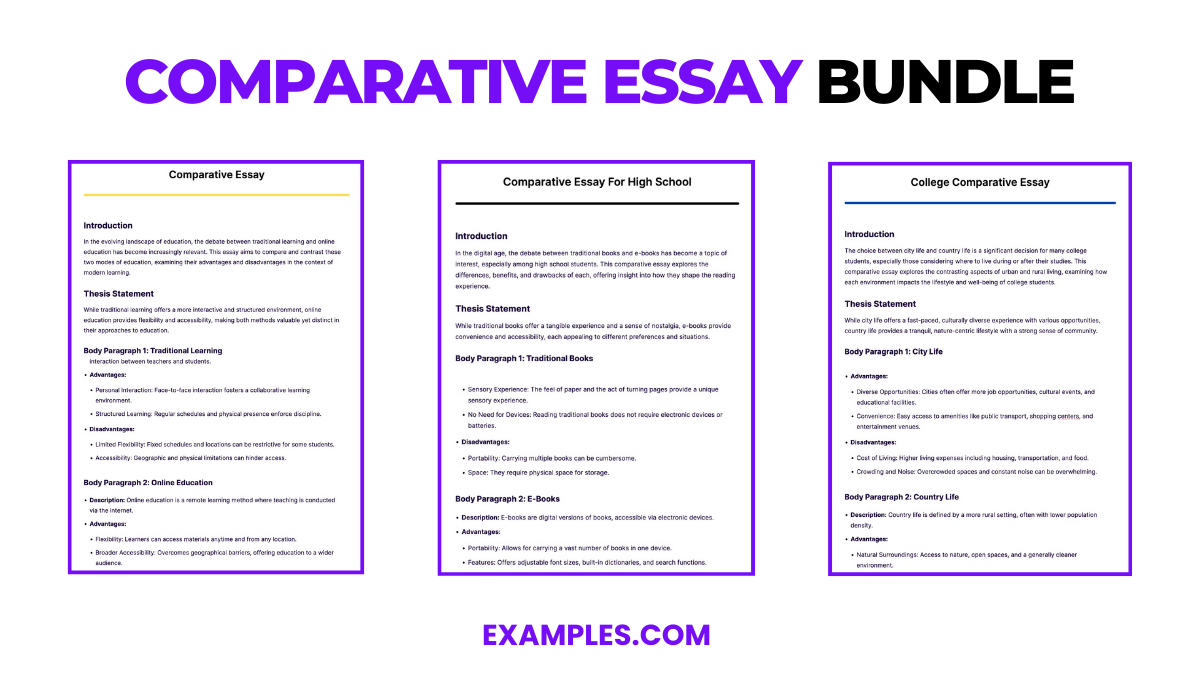
Download Comparative Essay Bundle
A comparative essay can either compare or contrast two topics, theories, materials and other subjects of discussion. However, there are activities where both comparisons and contrasts are necessary to be presented. If you are required to write a comparative essay but is unaware on how you can do one effectively, you can browse through the samples that we have gathered for you so you can be more knowledgeable on how to structure both the content and layout of this kind of essay.

Free Download
Comparative Essay For High School
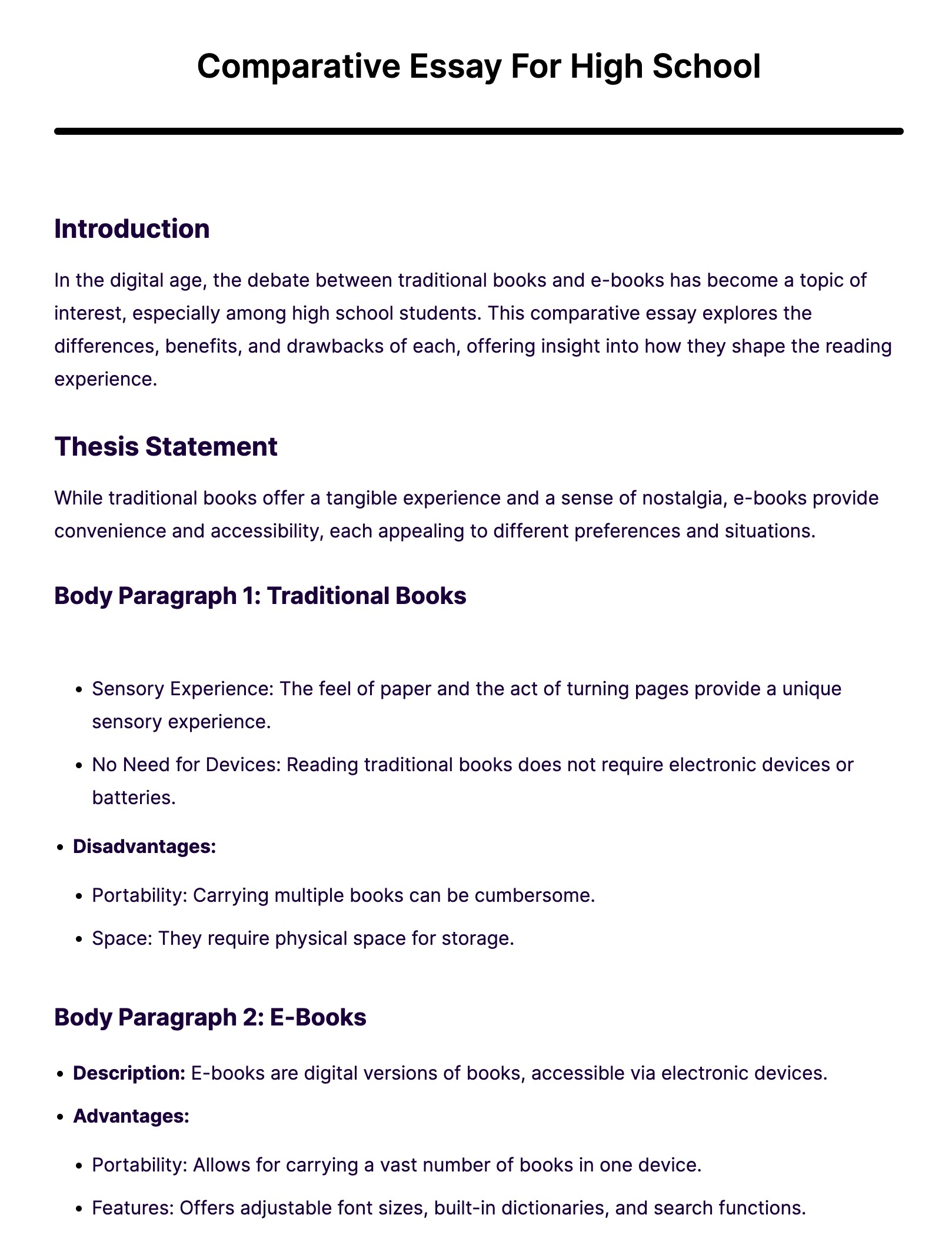
College Comparative Essay

Comparative Essay Plan Template
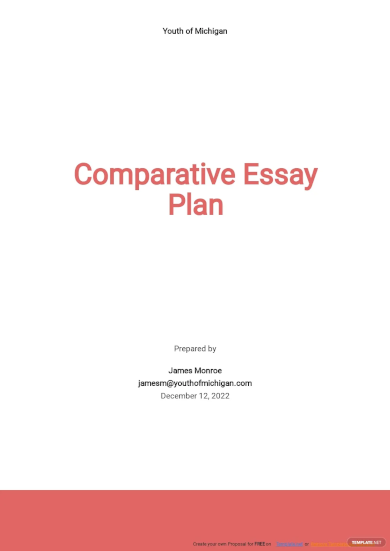
- Google Docs
- Apple Pages
Size: 28 KB
Compare and Contrast Sample Essay
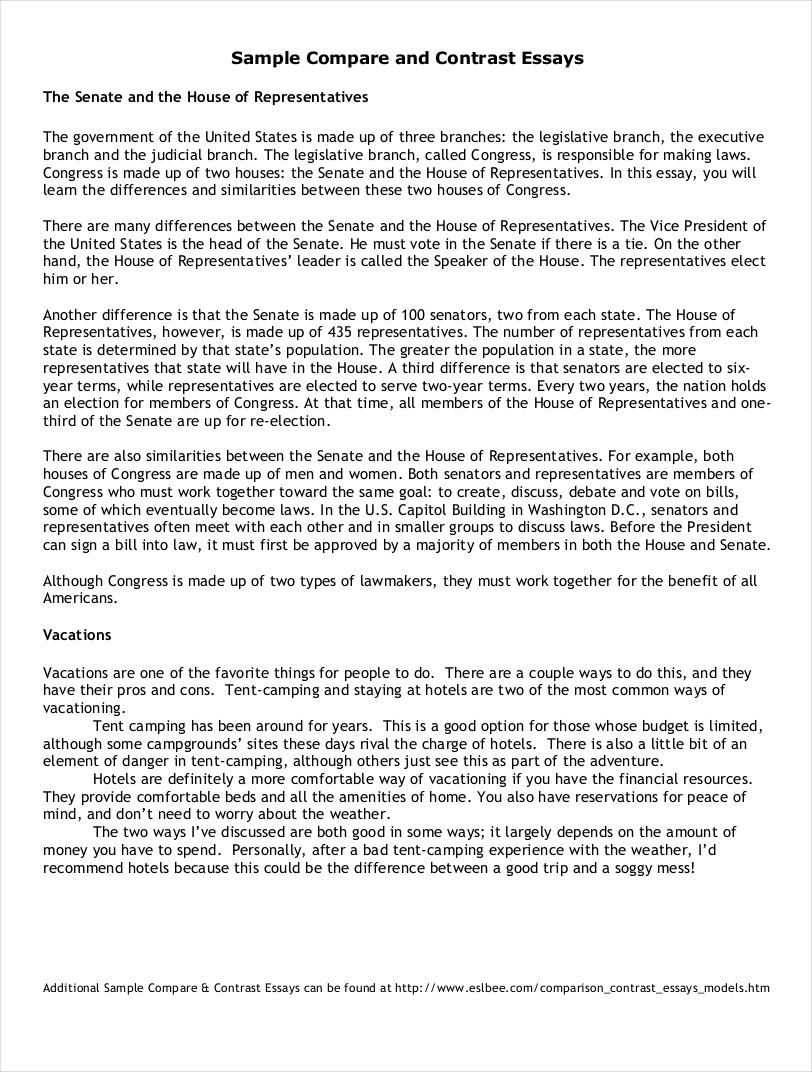
Size: 109 KB
Sample Comparative Essay Format
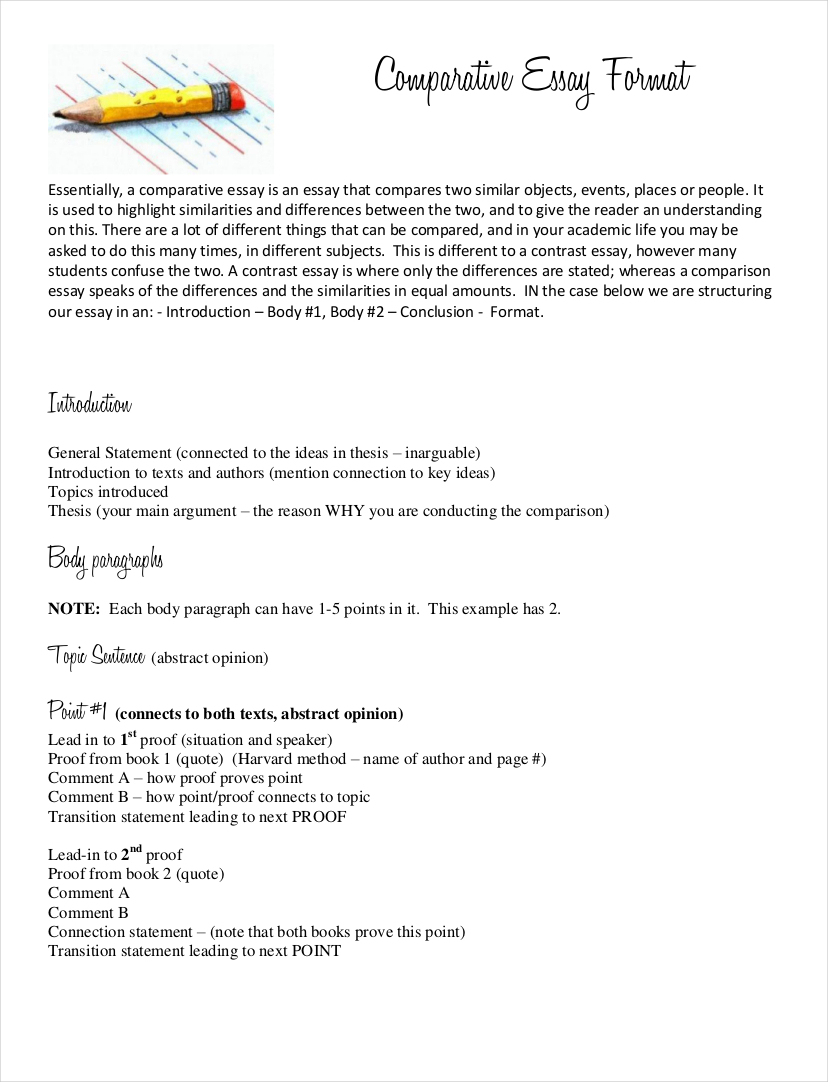
Size: 249 KB
The Concept of Comparative Essays
Different college essay examples are written based on different sets of instructions. Depending on the writing task that you have at hand, the things that you may include in your comparative essay may vary. However, the concept of making a comparative essay remains the same. For it to be clearer in your mind, here is how a comparative essay works:
- A comparative essay is an academic essay that requires students to create a comprehensive and precise comparative report about two things.
- A comparative essay is an organized written material that is meant to provide a comparison that should be easily understood by the target readers. It is set to impress people by providing them the information that they need to be aware of about two subjects and how they differ and/or compare with each other.
- A comparative essay can be written if you have two objects or subjects that can be compared in a level where their similarities and/or differences are relevant or meaningful for a specific purpose.
- A comparative essay can be used in formal writing assignments and it can also be the basis for various research assessments.
- A comparative essay is created through pertaining precise points of comparison. These points should be backed by actual researchers, factual information, and other reliable evidence.
Block Comparative Essay Example
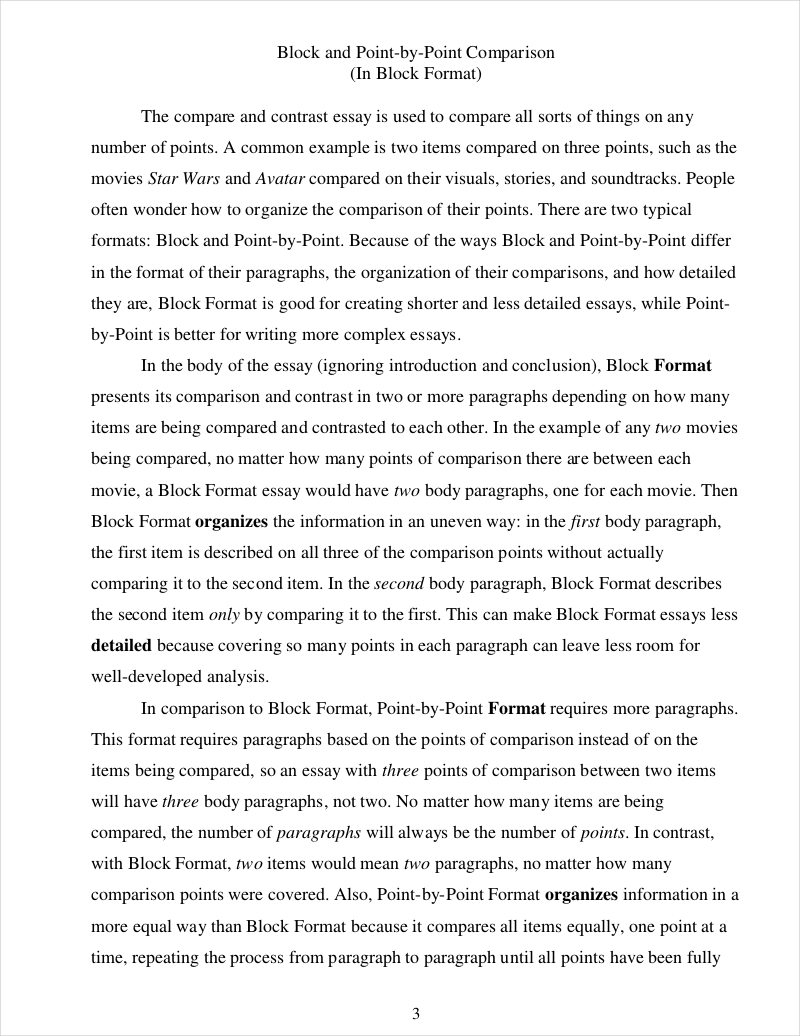
Size: 462 KB
Student Comparative Essay Sample
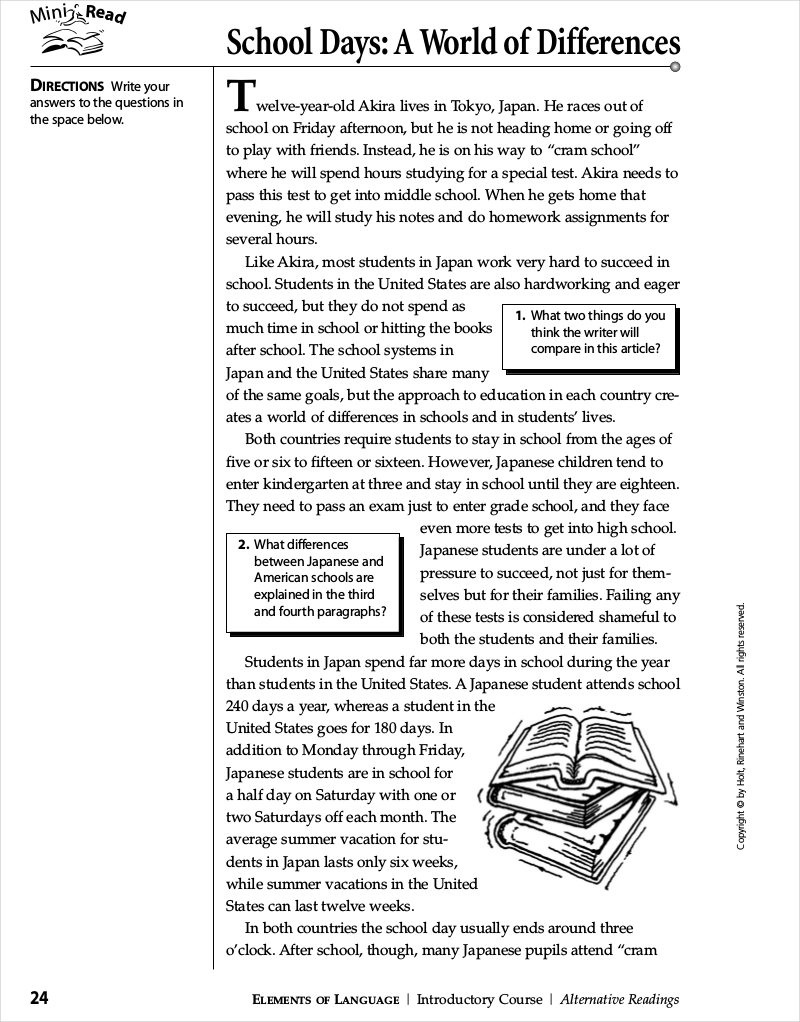
How to Develop the Content of Your Comparative Essay
Before writing a comparative essay, you first need to arm yourself with the information that you need. This will allow you to create a comparative essay that is filled with relevant and helpful information. More so, this can help you veer away from committing common essay mistakes if you are already in the process of actual content writing.
The way that you plan to present your ideas, especially if they are backed up with facts, can make your comparative essay more successful. Listed below are the steps that you may use when developing the content of your comparative essay.
- The first thing that you need to do is to be aware of the question that you need to answer. You need to be aware of the essay prompt so you can address the needs of your readers. It is essential for you to be fully knowledgeable of the essence of the question so you can interpret it accordingly. The content that you will write will only be effective if it is related to the question and if it matches the purpose on why the essay is necessary to be written.
- Know whether there are limits for your discussion . Always identify whether you need to know the similarities or the differences between your subjects. Also, you need to know whether the scope of your essay assignment requires you to do any of these or both.
- Select the ideas that you would like to compare. It is important for you to have an in-depth understanding of the kind of comparison that you will write. The framework of your essay should be based on an actual evaluation that can point out how you were able to perceive the similarities or differences of the subject.
- Assess whether you already have sufficient points for comparison. Your ability to present as many valid points as possible can make a lot of clarifications about the unanswered questions that you can enlighten your readers with.
- Once the points of your comparison are already specified, list down whether they are under the similarities or differences of the two subjects. This step can help you be organized throughout the writing process. With easy access to how subjects are compared, you can be guided on how to use them in your content development.
- Evaluate your list. Your list is only your initial view about the subjects being reviewed or assessed. Hence, further evaluation is necessary. Make sure that you will read through the entire list so you can rank them based on their impact and weight of thesis.
- Chronologically arrange your list based on your basis of comparison . Make sure that you will follow a metric when examining the items that you will place in your actual comparative essay.
- Know the approach that you will use when developing your essay content. Will you be theoretical? Will you focus on answering questions for comparison? It is essential for you to be aware of your basis so your approach can provide you with maximum benefits within the entirety of the content development process.
- Research further about your subjects so you can verify whether your claims and initial claims are correct. This can help you create more topics and gather more evidence that can support your comparison.
- Create a thesis statement where your discussion can set its foundation. This will enable you to start writing the comparative essay that you would like to achieve.
You may think that this is a very long process just for developing the ideas that you will present. In a way, you may be right. However, being prepared and ready on how you will attack and execute the writing assignment can make it easier for you to create a valid discussion.
Comparative Contrast Essay Template
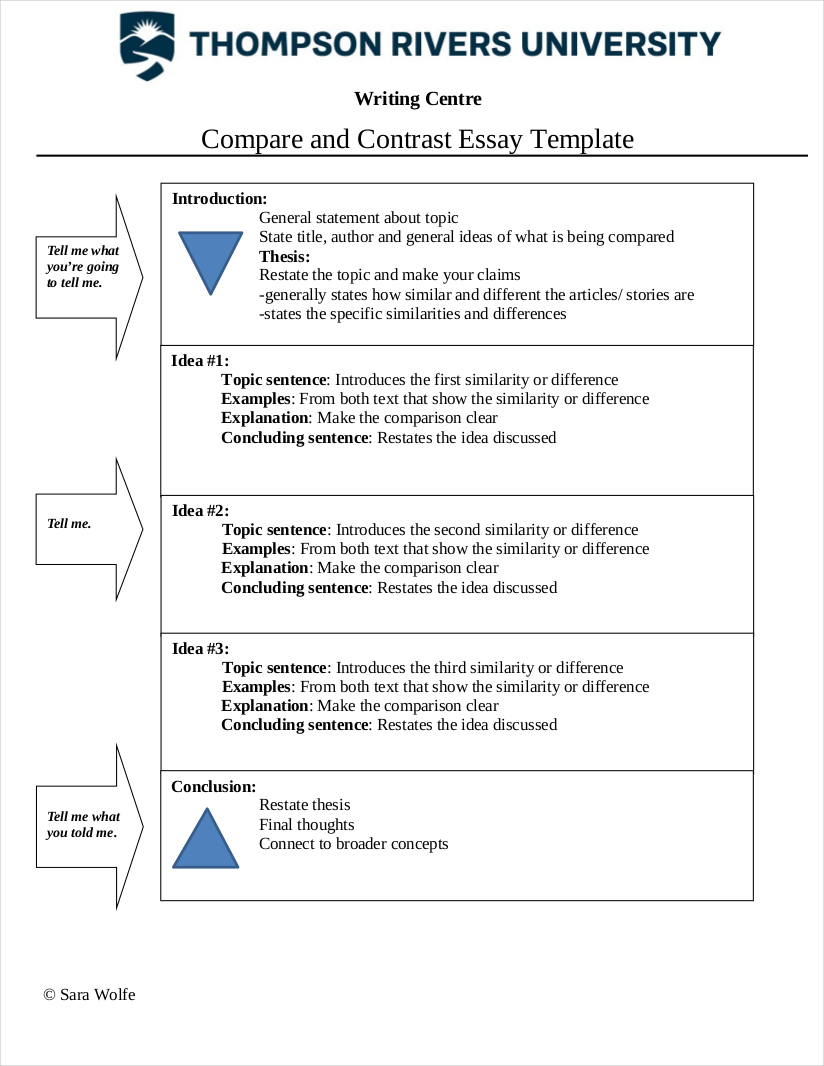
Size: 43 KB
Printable Comparative Essay Sample
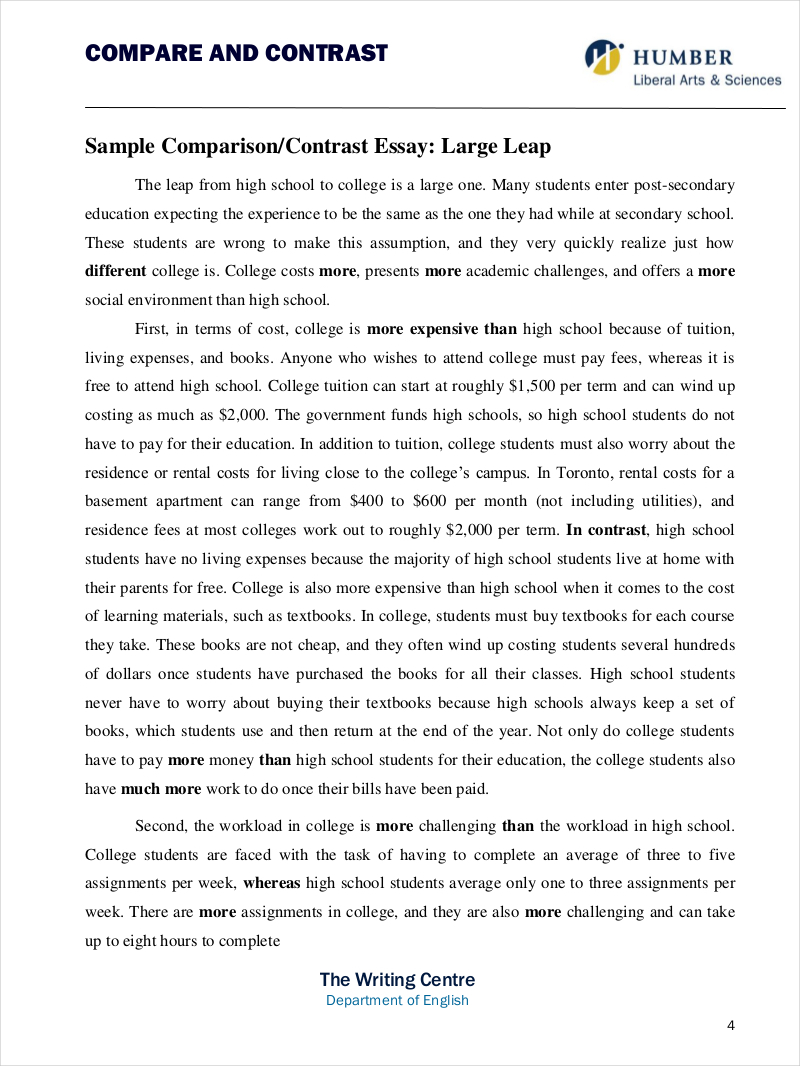
Size: 148 KB
Steps in Organizing Your Comparative Essay Discussion
Aside from knowing the idea of what you will write about, the structure of your essay or the organization of your essay’s content can affect the smooth flow of your discussion. Even during last minute essay writing activities, you can still come up with an outstanding comparative essay if you are already knowledgeable on how you can organize your essay’s idea, content, structure, and discussion. Listed below are some of the ways on how you can efficiently organize your comparative essay’s content.
- Refer to the outline of your comparisons. This is where the items that we have discussed above can be helpful. If you are already guided by your comparisons, then you can easily rank their relevance to the essay that you will write. Referencing your comparisons can make it easier for you to have a thesis statement that you can further discuss.
- Organize your writing strategies. The strategies that you will incorporate into your discussion can make it easier for readers to relate to your point. You need to make sure that your strategies are aligned with your type of comparison and the subjects that you are comparing.
- Properly address your comparisons. For your comparative essay to be highly-usable, you need to make sure that you will implement simplicity within your discussion. Do not make it complicated. The content of your comparative essay should be as simple as possible so that it can be furthermore understood.
- Organize your paragraph structure. The way that you create your paragraph listing can be one of the factors that can either improve or destroy your comparative essay. You should create a draft that can specifically state the items that you will discuss per paragraph. Create statements that can address specific comparisons and divide them per paragraph. Each of your paragraphs should be talking about one subject so you can give focus per comparison aspect.
- Evaluate whether your writing guide is already organized enough. It is essential for you to not overlap subjects of discussion. When organizing your statements, make sure to cover one subject at a time. This will help you create a comparative essay that contains a list of carefully arranged and curated evidence which are further discussed and broken down into relevant specification pieces.
Simple Essay of Comparison Sample
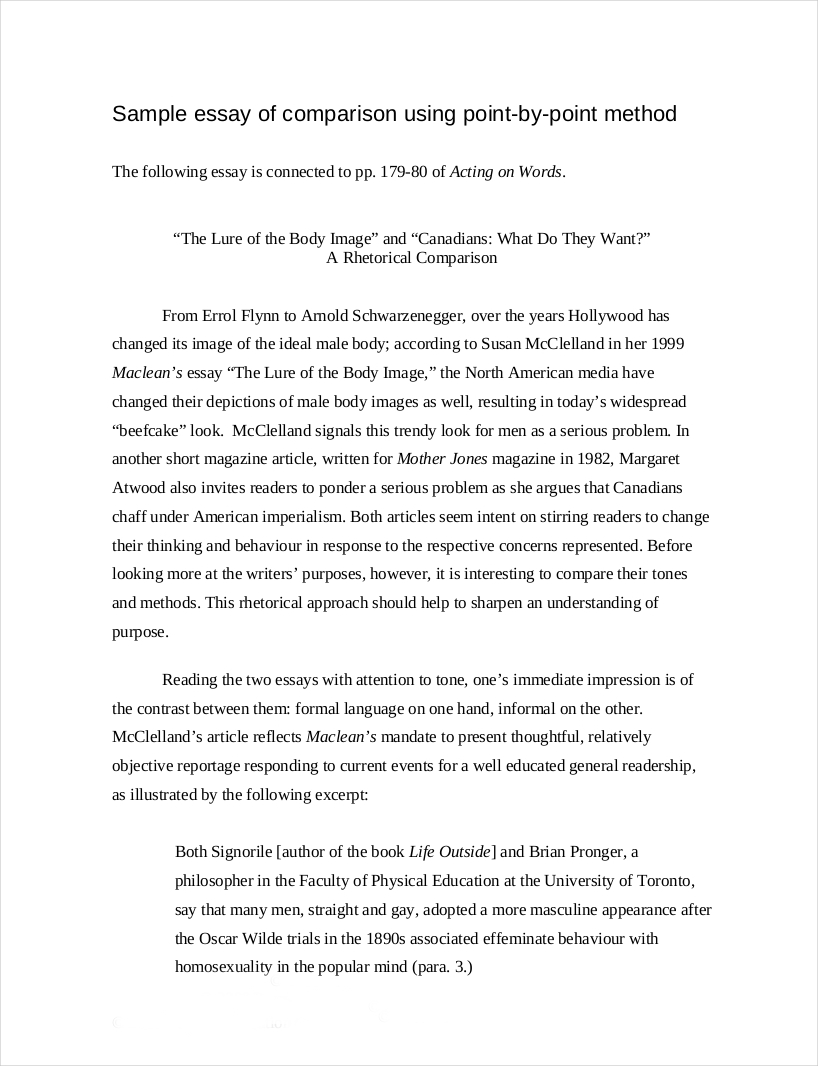
Size: 19 KB
Sample Comparative Essay in PDF
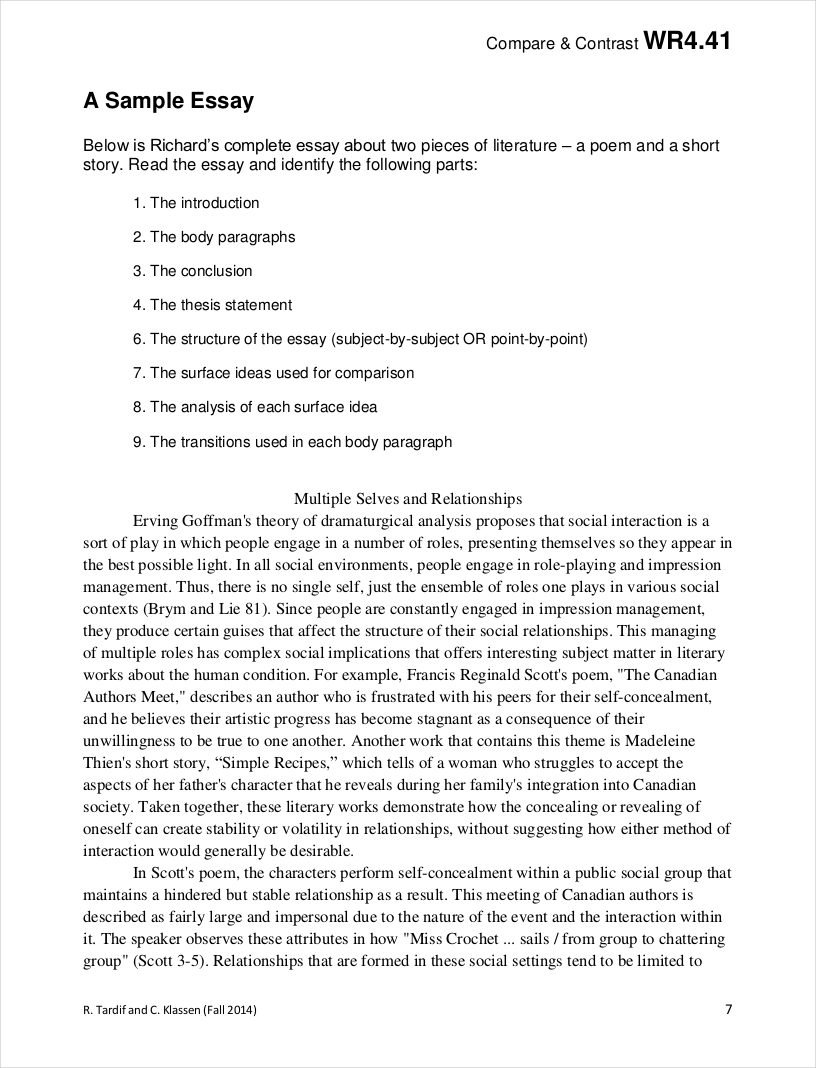
Size: 539 KB
Writing Guide in Creating the Actual Comparative Essay
Just like descriptive essay examples and other kinds of academic essays, a comparative essay can be created in different ways. Each writer has various techniques that can be applied when doing this particular kind of essay. Since there are no strict rules when it comes to crafting a comparative essay, all you need to ensure is that your comparative essay is comprehensive, understandable and credible. Here is how you can effectively write your actual comparative essay:
- Create an introduction to the topic. Your thesis statement should contain the subjects that you will talk about. You also need to create an initial discussion of what your readers can expect to the reader within the content of your comparative essay. A strong validation of your comparison can make your readers more interested to browse through the entire essay document.
- Develop your next paragraphs for discussion. As mentioned above, work per paragraph. Arrange your topics of discussion in a way that each paragraph can specifically state one comparison topic per time. You have to create an interesting discussion so you need to ensure that all your paragraphs are organized and well-written.
- Finalize your comparative essay with a conclusion. Your last paragraph should contain the information about your final thoughts with regards the comparison. How different or similar are the two subjects from one another? How sure are you that your basis is factual and relevant? Create a great impact b
- y having a conclusion that can put together all your points of discussion.
Compare Contrast Essay Sample
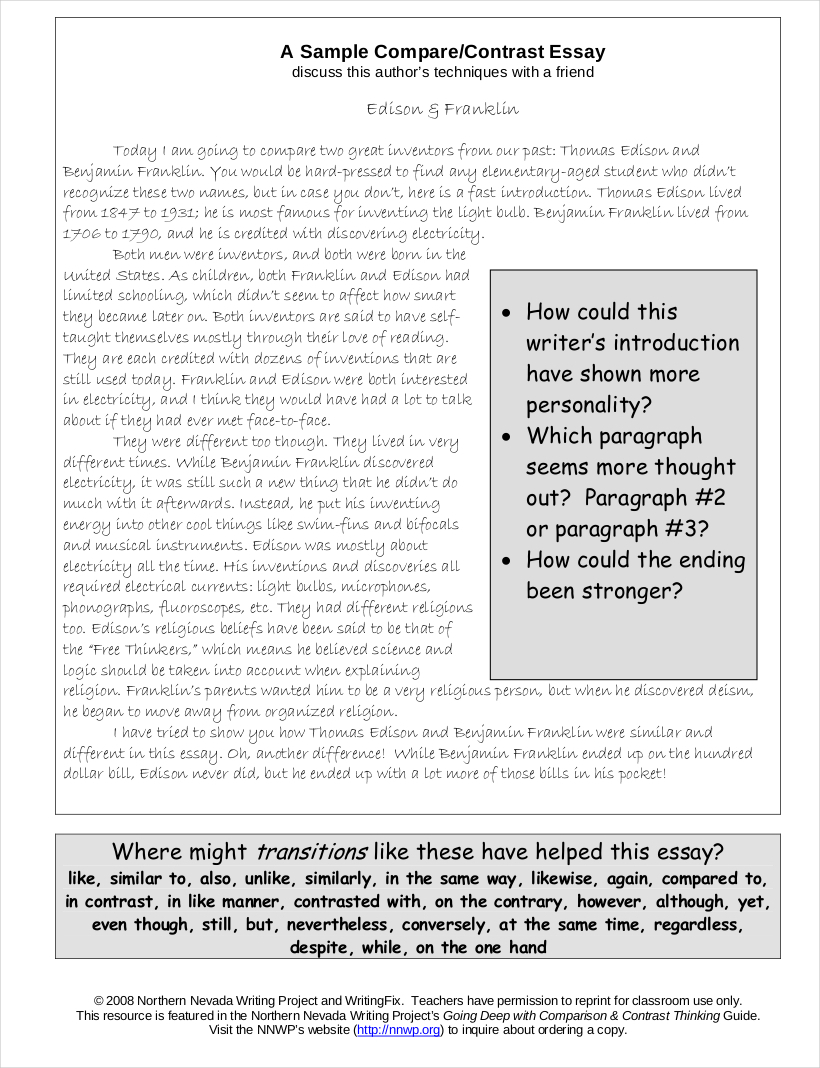
Size: 86 KB
Sample Comparative Essay Guide
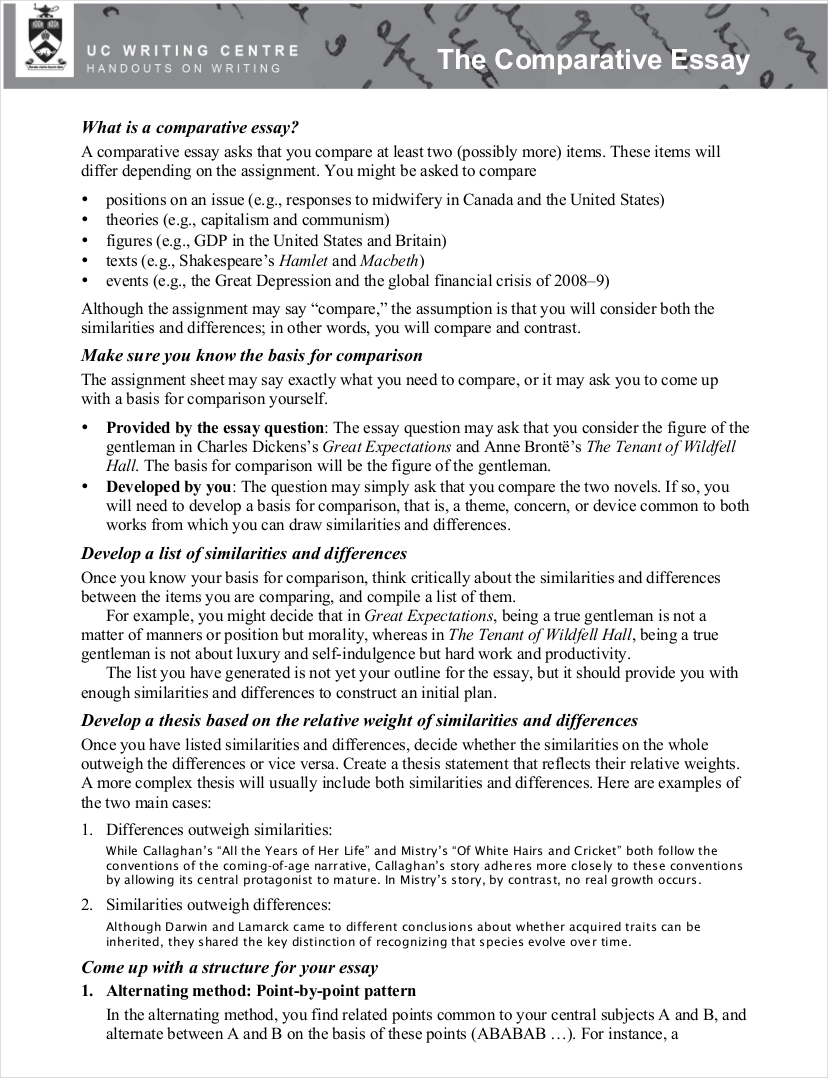
Size: 334 KB

Factors to Consider When Writing a Comparative Essay
In comparison to evaluation essay examples , a comparative essay is more keen with regards the assessment of two subjects. If you will write a comparative essay, you need to have an idea of the impacts of different factors to the result that you may get at the end of the writing activity. Listed below are some of the elements or factors that you need to take into consideration when writing a comparative essay.
- Your discussion’s organization. Within the entirety of the comparative essay creation, it is very evident that organization is key to success. As a writer, you need to ensure that you have a skeletal plan that can create your discussion more polished and coherent. The discussion of your organization can greatly affect the impression of your readers with regards your knowledge about your topic as well as your level of understanding with what you are talking about.
- Your thesis statement. When creating a comparative essay, you need to stick with an argument that can provide you the framework for the effective dissemination of information. Your thesis statement should be based on the results of your frame of references. You need to analyze your subjects properly so that you can create a stand on how you perceive them in levels of similarities and/or differences.
- Your claims or grounds for comparison. You should always be aware of your selection processes. At the end of the writing activity, you need to validate the importance of comparing two subjects. Always have your grounds of comparison ready so you can ensure your readers that you have followed a particular set of criteria that can enable the objectivity between the selection of two items for comparison. The rationale that you have behind your subject selection can make your comparative essay more appealing.
- Your reference frame. A comparative essay’s frame of reference deals with the way that the writer has created the groupings for the comparison. May it be talking about the similarities, differences, or both of these factors; a comparative essay should be able to have a reference that can identify how the characteristics of ideas, themes, theories or even problems are arranged.
With the samples that we have in this post, it will be faster for you to identify the points of discussion that you need to provide. Again, comparative essays vary from one another in terms of content. Ensure that you are fully aware of the writing instructions given to you so you can plan your comparative essay’s content and structure accordingly.
Always refer to the guidelines and tips that we have specified so you can create effective decisions in every step of your comparative essay development. Do not be afraid to write what your thoughts. As long as these thoughts are based on factual references, then it will be easy for you to have a comparative essay that can achieve its purpose or reason for creation.
the art of writing a comparative essay lies in the delicate balance of presenting similarities and differences in a clear, coherent manner. This type of essay encourages critical thinking and develops analytical skills, crucial for academic success. For further guidance on creating effective comparative essays, the UNC Writing Center offers a detailed resource on comparing and contrasting ( UNC Writing Center ). This link provides valuable insights and examples, helping students refine their comparative writing skills. By mastering the comparative essay, students not only enhance their writing abilities but also deepen their understanding of contrasting subjects, an essential skill in many academic and professional fields.
Comparative Essay Generator
Text prompt
- Instructive
- Professional
Write a comparative essay on cats vs. dogs as pets: which are better and why?
Compare in a comparative essay the effects of online learning vs. traditional classroom learning on students.
Comparative Essays
Writing a comparison usually requires that you assess the similarities and differences between two or more theories, procedures, or processes. You explain to your reader what insights can be gained from the comparison, or judge whether one thing is better than another according to established criteria.
How to Write a Comparative Essay
1. Establish a basis of comparison
A basis of comparison represents the main idea, category, or theme you will investigate. You will have to do some preliminary reading, likely using your course materials, to get an idea of what kind of criteria you will use to assess whatever you are comparing. A basis of comparison must apply to all items you are comparing, but the details will be different.
For example, if you are asked to “compare neoclassical architecture and gothic architecture,” you could compare the influence of social context on the two styles.
2. Gather the details of whatever you are comparing
Once you have decided what theme or idea you are investigating, you will need to gather details of whatever you are comparing, especially in terms of similarities and differences. Doing so allows you to see which criteria you should use in your comparison, if not specified by your professor or instructor.
- Appeal to Greek perfection
- Formulaic and mathematical
- Appeal to emotion
- Towers and spires
- Wild and rustic
- Civic buildings
Based on this information, you could focus on how ornamentation and design principles reveal prevailing intellectual thought about architecture in the respective eras and societies.
3. Develop a thesis statement
After brainstorming, try to develop a thesis statement that identifies the results of your comparison. Here is an example of a fairly common thesis statement structure:
e.g., Although neoclassical architecture and gothic architecture have [similar characteristics A and B], they reveal profound differences in their interpretation of [C, D, and E].
4. Organize your comparison
You have a choice of two basic methods for organizing a comparative essay: the point-by-point method or the block method.
The point-by-point method examines one aspect of comparison in each paragraph and usually alternates back and forth between the two objects, texts, or ideas being compared. This method allows you to emphasize points of similarity and of difference as you proceed.
In the block method, however, you say everything you need to say about one thing, then do the same thing with the other. This method works best if you want readers to understand and agree with the advantages of something you are proposing, such as introducing a new process or theory by showing how it compares to something more traditional.
Sample Outlines for Comparative Essays on Neoclassical and Gothic Architecture
Building a point-by-point essay.
Using the point-by-point method in a comparative essay allows you to draw direct comparisons and produce a more tightly integrated essay.
1. Introduction
- Introductory material
- Thesis: Although neoclassical and gothic architecture are both western European forms that are exemplified in civic buildings and churches, they nonetheless reveal through different structural design and ornamentation, the different intellectual principles of the two societies that created them.
2. Body Sections/Paragraphs
- Ornamentation in Text 1
- Ornamentation in Text 2
- Major appeal in Text 1
- Major appeal in Text 2
- Style in Text 1
- Style in Text 2
3. Conclusion
- Why this comparison is important?
- What does this comparison tell readers?
Building a Block Method Essay
Using the block method in a comparative essay can help ensure that the ideas in the second block build upon or extend ideas presented in the first block. It works well if you have three or more major areas of comparison instead of two (for example, if you added in a third or fourth style of architecture, the block method would be easier to organize).
- Thesis: The neoclassical style of architecture was a conscious rejection of the gothic style that had dominated in France at the end of the middle ages; it represented a desire to return to the classical ideals of Greece and Rome.
- History and development
- Change from earlier form
- Social context of new form
- What does the comparison reveal about architectural development?
- Why is this comparison important?
- PRO Courses Guides New Tech Help Pro Expert Videos About wikiHow Pro Upgrade Sign In
- EDIT Edit this Article
- EXPLORE Tech Help Pro About Us Random Article Quizzes Request a New Article Community Dashboard This Or That Game Popular Categories Arts and Entertainment Artwork Books Movies Computers and Electronics Computers Phone Skills Technology Hacks Health Men's Health Mental Health Women's Health Relationships Dating Love Relationship Issues Hobbies and Crafts Crafts Drawing Games Education & Communication Communication Skills Personal Development Studying Personal Care and Style Fashion Hair Care Personal Hygiene Youth Personal Care School Stuff Dating All Categories Arts and Entertainment Finance and Business Home and Garden Relationship Quizzes Cars & Other Vehicles Food and Entertaining Personal Care and Style Sports and Fitness Computers and Electronics Health Pets and Animals Travel Education & Communication Hobbies and Crafts Philosophy and Religion Work World Family Life Holidays and Traditions Relationships Youth
- Browse Articles
- Learn Something New
- Quizzes Hot
- This Or That Game New
- Train Your Brain
- Explore More
- Support wikiHow
- About wikiHow
- Log in / Sign up
- Education and Communications
- College University and Postgraduate
- Academic Writing
How to Write a Comparative Essay
Last Updated: May 19, 2023 Fact Checked
This article was co-authored by Christopher Taylor, PhD . Christopher Taylor is an Adjunct Assistant Professor of English at Austin Community College in Texas. He received his PhD in English Literature and Medieval Studies from the University of Texas at Austin in 2014. There are 8 references cited in this article, which can be found at the bottom of the page. This article has been fact-checked, ensuring the accuracy of any cited facts and confirming the authority of its sources. This article has been viewed 1,682,346 times.
Perhaps you have been assigned a comparative essay in class, or need to write a comprehensive comparative report for work. In order to write a stellar comparative essay, you have to start off by picking two subjects that have enough similarities and differences to be compared in a meaningful way, such as two sports teams or two systems of government. Once you have that, then you have to find at least two or three points of comparison and use research, facts, and well-organized paragraphs to impress and captivate your readers. Writing the comparative essay is an important skill that you will use many times throughout your scholastic career.
Comparative Essay Outline and Example

How to Develop the Essay Content

- Many comparative essay assignments will signal their purpose by using words such as "compare," "contrast," "similarities," and "differences" in the language of the prompt.
- Also see whether there are any limits placed on your topic.

- The assignment will generally ask guiding questions if you are expected to incorporate comparison as part of a larger assignment. For example: "Choose a particular idea or theme, such as love, beauty, death, or time, and consider how two different Renaissance poets approach this idea." This sentence asks you to compare two poets, but it also asks how the poets approach the point of comparison. In other words, you will need to make an evaluative or analytical argument about those approaches.
- If you're unclear on what the essay prompt is asking you to do, talk with your instructor. It's much better to clarify questions up front than discover you've written the entire essay incorrectly.

- The best place to start is to write a list of things that the items you are comparing have in common as well as differences between them. [3] X Research source

- You may want to develop a system such as highlighting different types of similarities in different colors, or use different colours if you are using an electronic device.
- For example, if you are comparing two novels, you may want to highlight similarities in characters in pink, settings in blue, and themes or messages in green.

- The basis for your comparison may be assigned to you. Be sure to check your assignment or prompt.
- A basis for comparison may have to do with a theme, characteristics, or details about two different things. [7] X Research source
- A basis for comparison may also be known as the “grounds” for comparison or a frame of reference.
- Keep in mind that comparing 2 things that are too similar makes it hard to write an effective paper. The goal of a comparison paper is to draw interesting parallels and help the reader realize something interesting about our world. This means your subjects must be different enough to make your argument interesting.

- Research may not be required or appropriate for your particular assignment. If your comparative essay is not meant to include research, you should avoid including it.
- A comparative essay about historical events, social issues, or science-related topics are more likely to require research, while a comparison of two works of literature are less likely to require research.
- Be sure to cite any research data properly according to the discipline in which you are writing (eg, MLA, APA, or Chicago format).

- Your thesis needs to make a claim about your subjects that you will then defend in your essay. It's good for this claim to be a bit controversial or up for interpretation, as this allows you to build a good argument.
How to Organize the Content

- Use a traditional outline form if you would like to, but even a simple list of bulleted points in the order that you plan to present them would help.
- You can also write down your main points on sticky notes (or type them, print them, and then cut them out) so that you can arrange and rearrange them before deciding on a final order.

- The advantages of this structure are that it continually keeps the comparison in the mind of the reader and forces you, the writer, to pay equal attention to each side of the argument.
- This method is especially recommended for lengthy essays or complicated subjects where both the writer and reader can easily become lost. For Example: Paragraph 1: Engine power of vehicle X / Engine power of vehicle Y Paragraph 2: Stylishness of vehicle X / Stylishness of vehicle Y Paragraph 3: Safety rating of vehicle X / Safety rating of vehicle Y

- The advantages of this structure are that it allows you to discuss points in greater detail and makes it less jarring to tackle two topics that radically different.
- This method is especially recommended for essays where some depth and detail are required. For example: Paragraph 1: Engine power of vehicle X Paragraph 2: Engine power of vehicle Y Paragraph 3: Stylishness of vehicle X Paragraph 4: Stylishness of vehicle Y Paragraph 5: Safety rating of vehicle X Paragraph 6: Safety rating of vehicle Y

- This method is by far the most dangerous, as your comparison can become both one-sided and difficult for the reader to follow.
- This method is only recommended for short essays with simplistic subjects that the reader can easily remember as (s)he goes along. For example: Paragraph 1: Engine power of vehicle X Paragraph 2: Stylishness of vehicle X Paragraph 3: Safety rating of vehicle X Paragraph 4: Engine power of vehicle Y Paragraph 5: Stylishness of vehicle Y Paragraph 6: Safety rating of vehicle Y
How to Write the Essay

- Body paragraphs first . Work through all that information you've been compiling and see what kind of story it tells you. Only when you've worked with your data will you know what the larger point of the paper is.
- Conclusion second . Now that you've done all the heavy lifting, the point of your essay should be fresh in your mind. Strike while the iron’s hot. Start your conclusion with a restatement of your thesis.
- Intro last . Open your introduction with a "hook" to grab the reader's attention. Since you've already written your essay, choose a hook that reflects what you will talk about, whether it's a quote, statistic, factoid, rhetorical question, or anecdote. Then, write 1-2 sentences about your topic, narrowing down to your thesis statement, which completes your introduction.

- Organize your paragraphs using one of the approaches listed in the "Organizing the Content" part below. Once you have defined your points of comparison, choose the structure for the body paragraphs (where your comparisons go) that makes the most sense for your data. To work out all the organizational kinks, it’s recommended that you write an outline as a placeholder.
- Be very careful not to address different aspects of each subject. Comparing the color of one thing to the size of another does nothing to help the reader understand how they stack up. [15] X Research source

- Be aware that your various comparisons won’t necessarily lend themselves to an obvious conclusion, especially because people value things differently. If necessary, make the parameters of your argument more specific. (Ex. “Though X is more stylish and powerful, Y’s top safety ratings make it a more appropriate family vehicle .”)
- When you have two radically different topics, it sometimes helps to point out one similarity they have before concluding. (i.e. "Although X and Y don't seem to have anything in common, in actuality, they both ....”)

- Even the best writers know editing is important to produce a good piece. Your essay will not be your best effort unless you revise it.
- If possible, find a friend to look over the essay, as he or she may find problems that you missed.
- It sometimes helps to increase or decrease the font size while editing to change the visual layout of the paper. Looking at the same thing for too long makes your brain fill in what it expects instead of what it sees, leaving you more likely to overlook errors.
Expert Q&A

- The title and introduction really catch the reader's attention and make them read the essay. Make sure you know how to write a catchy essay title . Thanks Helpful 6 Not Helpful 1
- Quotes should be used sparingly and must thoroughly complement the point they are being used to exemplify/justify. Thanks Helpful 5 Not Helpful 2
- The key principle to remember in a comparative paragraph or essay is that you must clarify precisely what you are comparing and keep that comparison alive throughout the essay. Thanks Helpful 3 Not Helpful 2

- Avoid vague language such as "people," "stuff," "things," etc. Thanks Helpful 4 Not Helpful 0
- Avoid, at all costs, the conclusion that the two subjects are "similar, yet different." This commonly found conclusion weakens any comparative essay, because it essentially says nothing about the comparison. Most things are "similar, yet different" in some way. Thanks Helpful 4 Not Helpful 0
- Some believe that an "unbalanced" comparison - that is, when the essay focuses predominantly on one of the two issues, and gives less importance to the other - is weaker, and that writers should strive for 50/50 treatment of the texts or issues being examined. Others, however, value emphasis in the essay that reflects the particular demands of the essay's purpose or thesis. One text may simply provide context, or historical/artistic/political reference for the main text, and therefore need not occupy half of the essay's discussion or analysis. A "weak" essay in this context would strive to treat unequal texts equally, rather than strive to appropriately apportion space to the relevant text. Thanks Helpful 3 Not Helpful 0
- Beware of the "Frying Pan Conclusion" in which you simply recount everything that was said in the main body of the essay. While your conclusion should include a simple summary of your argument, it should also emphatically state the point in a new and convincing way, one which the reader will remember clearly. If you can see a way forward from a problem or dilemma, include that as well. Thanks Helpful 2 Not Helpful 1
You Might Also Like

- ↑ http://writingcenter.unc.edu/handouts/comparing-and-contrasting/
- ↑ http://www.writing.utoronto.ca/advice/specific-types-of-writing/comparative-essay
- ↑ https://writingcenter.unc.edu/tips-and-tools/comparing-and-contrasting/
- ↑ http://writingcenter.fas.harvard.edu/pages/how-write-comparative-analysis
- ↑ https://www.butte.edu/departments/cas/tipsheets/style_purpose_strategy/compare_contrast.html
- ↑ https://open.lib.umn.edu/writingforsuccess/chapter/10-7-comparison-and-contrast/
- ↑ https://owl.purdue.edu/owl/general_writing/the_writing_process/proofreading/steps_for_revising.html
- How to Structure Paragraphs in an Essay
About This Article

To write a comparative essay, start by writing an introduction that introduces the 2 subjects you'll be comparing. You should also include your thesis statement in the introduction, which should state what you've concluded based on your comparisons. Next, write the body of your essay so that each paragraph focuses on one point of comparison between your subjects. Finally, write a conclusion that summarizes your main points and draws a larger conclusion about the two things you compared. To learn how to do research for your essay, read on! Did this summary help you? Yes No
- Send fan mail to authors
Reader Success Stories
Nov 21, 2017
Did this article help you?

Lisa Taylor
Aug 19, 2017
Brayden Ryan
Aug 10, 2016
Antwanette Nottage
Feb 5, 2019
Bernice Sangmortey
Nov 5, 2017

Featured Articles

Trending Articles

Watch Articles

- Terms of Use
- Privacy Policy
- Do Not Sell or Share My Info
- Not Selling Info
Get all the best how-tos!
Sign up for wikiHow's weekly email newsletter

- school Campus Bookshelves
- menu_book Bookshelves
- perm_media Learning Objects
- login Login
- how_to_reg Request Instructor Account
- hub Instructor Commons
- Download Page (PDF)
- Download Full Book (PDF)
- Periodic Table
- Physics Constants
- Scientific Calculator
- Reference & Cite
- Tools expand_more
- Readability
selected template will load here
This action is not available.

4.1: Introduction to Comparison and Contrast Essay
- Last updated
- Save as PDF
- Page ID 174873
The key to a good compare-and-contrast essay is to choose two or more subjects that connect in a meaningful way. Comparison and contrast is simply telling how two things are alike or different. The compare-and-contrast essay starts with a thesis that clearly states the two subjects that are to be compared, contrasted, or both. The thesis should focus on comparing, contrasting, or both.
Key Elements of the Compare and Contrast:
- A compare-and-contrast essay analyzes two subjects by either comparing them, contrasting them, or both.
- The purpose of writing a comparison or contrast essay is not to state the obvious but rather to illuminate subtle differences or unexpected similarities between two subjects.
- The thesis should clearly state the subjects that are to be compared, contrasted, or both, and it should state what is to be learned from doing so.
- Organize by the subjects themselves, one then the other.
- Organize by individual points, in which you discuss each subject in relation to each point.
- Use phrases of comparison or phrases of contrast to signal to readers how exactly the two subjects are being analyzed.
Objectives: By the end of this unit, you will be able to
- Identify compare & contrast relationships in model essays
- Construct clearly formulated thesis statements that show compare & contrast relationships
- Use pre-writing techniques to brainstorm and organize ideas showing a comparison and/or contrast
- Construct an outline for a five-paragraph compare & contrast essay
- Write a five-paragraph compare & contrast essay
- Use a variety of vocabulary and language structures that express compare & contrast essay relationships
Example Thesis: Organic vegetables may cost more than those that are conventionally grown, but when put to the test, they are definitely worth every extra penny.

Sample Paragraph:
Organic grown tomatoes purchased at the farmers’ market are very different from tomatoes that are grown conventionally. To begin with, although tomatoes from both sources will mostly be red, the tomatoes at the farmers’ market are a brighter red than those at a grocery store. That doesn’t mean they are shinier—in fact, grocery store tomatoes are often shinier since they have been waxed. You are likely to see great size variation in tomatoes at the farmers’ market, with tomatoes ranging from only a couple of inches across to eight inches across. By contrast, the tomatoes in a grocery store will be fairly uniform in size. All the visual differences are interesting, but the most important difference is the taste. The farmers’ market tomatoes will be bursting with flavor from ripening on the vine in their own time. However, the grocery store tomatoes are often close to being flavorless. In conclusion, the differences in organic and conventionally grown tomatoes are obvious in color, size and taste.

5 Compare and Contrast Essay Examples (Full Text)
A compare and contrast essay selects two or more items that are critically analyzed to demonstrate their differences and similarities. Here is a template for you that provides the general structure:

A range of example essays is presented below.
Compare and Contrast Essay Examples
#1 jean piaget vs lev vygotsky essay.
1480 Words | 5 Pages | 10 References
(Level: University Undergraduate)

Thesis Statement: “This essay will critically examine and compare the developmental theories of Jean Piaget and Lev Vygotsky, focusing on their differing views on cognitive development in children and their influence on educational psychology, through an exploration of key concepts such as the role of culture and environment, scaffolding, equilibration, and their overall implications for educational practices..”
#2 Democracy vs Authoritarianism Essay

Thesis Statement: “The thesis of this analysis is that, despite the efficiency and control offered by authoritarian regimes, democratic systems, with their emphasis on individual freedoms, participatory governance, and social welfare, present a more balanced and ethically sound approach to governance, better aligned with the ideals of a just and progressive society.”
#3 Apples vs Oranges Essay
1190 Words | 5 Pages | 0 References
(Level: 4th Grade, 5th Grade, 6th Grade)

Thesis Statement: “While apples and oranges are both popular and nutritious fruits, they differ significantly in their taste profiles, nutritional benefits, cultural symbolism, and culinary applications.”
#4 Nature vs Nurture Essay
1525 Words | 5 Pages | 11 References
(Level: High School and College)

Thesis Statement: “The purpose of this essay is to examine and elucidate the complex and interconnected roles of genetic inheritance (nature) and environmental influences (nurture) in shaping human development across various domains such as physical traits, personality, behavior, intelligence, and abilities.”
#5 Dogs vs Cats Essay
1095 Words | 5 Pages | 7 Bibliographic Sources
(Level: 6th Grade, 7th Grade, 8th Grade)
Thesis Statement: “This essay explores the distinctive characteristics, emotional connections, and lifestyle considerations associated with owning dogs and cats, aiming to illuminate the unique joys and benefits each pet brings to their human companions.”
How to Write a Compare and Contrast Essay
I’ve recorded a full video for you on how to write a compare and contrast essay:
Get the Compare and Contrast Templates with AI Prompts Here
In the video, I outline the steps to writing your essay. Here they are explained below:
1. Essay Planning
First, I recommend using my compare and contrast worksheet, which acts like a Venn Diagram, walking you through the steps of comparing the similarities and differences of the concepts or items you’re comparing.
I recommend selecting 3-5 features that can be compared, as shown in the worksheet:

Grab the Worksheet as Part of the Compare and Contrast Essay Writing Pack
2. Writing the Essay
Once you’ve completed the worksheet, you’re ready to start writing. Go systematically through each feature you are comparing and discuss the similarities and differences, then make an evaluative statement after showing your depth of knowledge:

Get the Rest of the Premium Compare and Contrast Essay Writing Pack (With AI Prompts) Here
How to Write a Compare and Contrast Thesis Statement
Compare and contrast thesis statements can either:
- Remain neutral in an expository tone.
- Prosecute an argument about which of the items you’re comparing is overall best.
To write an argumentative thesis statement for a compare and contrast essay, try this AI Prompts:
💡 AI Prompt to Generate Ideas I am writing a compare and contrast essay that compares [Concept 1] and [Concept2]. Give me 5 potential single-sentence thesis statements that pass a reasonable judgement.
Ready to Write your Essay?

Take action! Choose one of the following options to start writing your compare and contrast essay now:
Read Next: Process Essay Examples

Chris Drew (PhD)
Dr. Chris Drew is the founder of the Helpful Professor. He holds a PhD in education and has published over 20 articles in scholarly journals. He is the former editor of the Journal of Learning Development in Higher Education. [Image Descriptor: Photo of Chris]
- Chris Drew (PhD) https://helpfulprofessor.com/author/chris-drew-phd/ 5 Top Tips for Succeeding at University
- Chris Drew (PhD) https://helpfulprofessor.com/author/chris-drew-phd/ 50 Durable Goods Examples
- Chris Drew (PhD) https://helpfulprofessor.com/author/chris-drew-phd/ 100 Consumer Goods Examples
- Chris Drew (PhD) https://helpfulprofessor.com/author/chris-drew-phd/ 30 Globalization Pros and Cons
Leave a Comment Cancel Reply
Your email address will not be published. Required fields are marked *
Take 10% OFF— Expires in h m s Use code save10u during checkout.
Chat with us
- Live Chat Talk to a specialist
- Self-service options
- Search FAQs Fast answers, no waiting
- Ultius 101 New client? Click here
- Messenger
International support numbers
For reference only, subject to Terms and Fair Use policies.
- How it Works
Learn more about us
- Future writers
- Explore further
How to write a comparative essay
A step-by-step guide with instructions, outlines, and samples
Writing a great comparative essay means highlighting the similarities and differences between two things in a systematic manner. Start by choosing the parameters (items) to compare, write an outline, and fill in the details for each section. Make sure to have an introduction and conclusion.
The comparative essay is one form of document that you will probably be expected to write at some point over the course of your college career. The purpose of this article is to provide you with a thorough overview of the comparative essay. Specific things that will be addressed include:
Purpose of the comparative essay
Explanation of comparative models, how to analyze subjects, elements of a good comparative essay, how to write a great comparative essay.
- Samples/examples
- Best practices and advice
- Additional information
By the end of this article, you should feel more confident about your own knowledge of what a comparative essay is and the best ways to go about writing one (if you haven't decided to buy a comparative essay from Ultius ).

The fundamental purpose of a comparative essay is to elaborate the similarities and differences between two things in a systematic manner.
An effective comparative essay will leave the reader with much greater clarity about the natures and properties of the things that have been compared.
This could potentially serve as a basis for making a decision in favor of one or the other thing.
A comparative essay is different from, for example, an argumentative essay in that the comparative essay does not make a case for either of the two things under comparison. Rather, the point is to simply set up the comparison so that the reader will have as much information about the two things as possible.
Why are comparative essays important?
The comparative essay is an important form of document because when you have to make a decision or choose a side in an argument, you will want to know as much as possible about the two options under consideration—and a good comparative essay on the subject can bring out both the similarities and the differences between the options, thereby clarifying the stakes at play.
For example, a comparative essay could address the similarities and differences between any of the following pairs:
- The Republican Party and the Democratic Party
- Christianity and Marxism
- The Big Bang and creationism
- The Light or Dark side of the Force from Star Wars
- The revolutionary and the reformist perspectives on social change
By developing a comparative essay on any of these pairs, you can not only understand each item of under comparison is a more thorough way, you can also get closer to figuring out which item you prefer.
For example, a solid comparative essay on revolution vs. reformism could not only help you understand what each of these items entails, it can also help you figure out whether you would rather be a revolutionary or a reformist. Likewise, if you only have time to binge watch one show, then a comparative essay could help you figure out whether you would prefer to go with Game of Thrones or Westworld .
When writing a comparative essay, there are several models you can use in order to ensure that you set up your comparison as effectively as possible.
Venn diagram
The Venn diagram is a classic, and surely, you're familiar with it. This is the model of two overlapping circles, where each circle belongs to one item of comparison: features shared by both items (similarities) go in the overlapping middle zone, whereas features that are not shared go in the outer areas. For example, here is a Venn diagram that compares humans against gorillas.
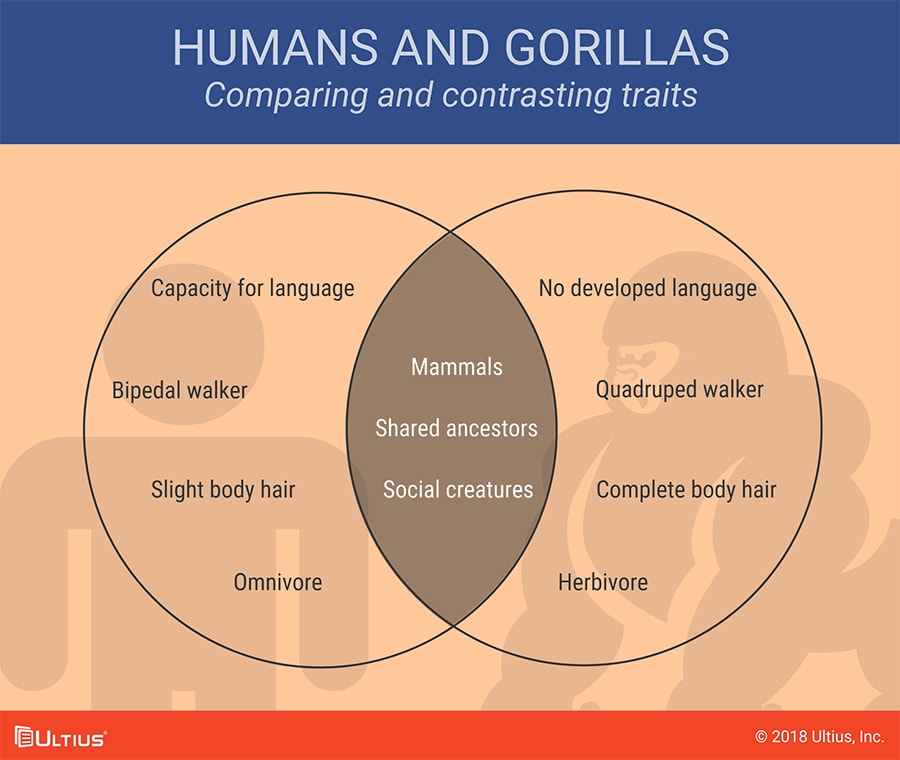
When using the Venn diagram model, it is important to note that the differences must be symmetrical. In other words, every difference you list on one side of the comparison must be matched by a difference on the other side.
For example, if you were comparing Apple and Amazon, then for the parameter of "founder," you can list "Steve Jobs" in one circle and "Jeff Bezos" in the other. But it wouldn't make sense if you just listed one or the other: you must list something for each of the items of comparisons under the selected parameter of comparison.
In the Venn diagram above, the first parameter is "language," so for humans it is listed that we have a capacity of language, whereas for gorillas it is listed that they do not.
You don't need to worry about this kind of symmetry when it comes to the similarities, since you will list the same thing for both items of comparison (which means you only have to list it once, in the overlapping zone). In the example, above, the fact that both humans and gorillas are mammals is thus listed just once in the middle.
The dialectical method
The dialectical method is important within the discipline of philosophy, and it has been used to great effect by thinkers such as Socrates and Hegel and Kierkegaard.
This involves holding two ideas or items in tension with each other, to better clarify not only the ideas themselves but also the dynamic relationship that exist between the ideas. The first idea is called the thesis , and the second idea is called the antithesis .
For example, Romanticism could be dialectically compared against the Enlightenment that came before it, because Romanticism was in some ways a rejection of the previous worldview.
Need help? Essay writing services from Ultius can help you produce a great sample compare and contrast essay.
So, by setting up a comparison between Romanticism and the Enlightenment, it becomes possible to see both the continuities (or similarities) between the one and the other, as well as the contradictions (or differences) between them.
Berlin, Isaiah. The Roots of Romanticism . Princeton: Princeton U P, 2013. Print.
From the table above, it is clear that we are able to understand both Romanticism and the Enlightenment better if we set them up in terms of dialectical contrast.
Clearly, they are different in some important ways (logic vs. passion, for example), but we can also see that they are in continuity with each other (both happened in Western Europe and responded to previous developments). This comparison also leads one to wonder about whether it would be possible to make a synthesis that takes the best from both the thesis and the antithesis
A good comparative essay can lead one to ask such questions and pursue such lines of inquiry.
To analyze your subjects for a comparative essay, you need to identify clear parameters, or axes, in terms of which your two selected items can be compared. For example, in the table above, Romanticism and the Enlightenment were compared along the axis of " epistemology ". But that axis won't be relevant to all subjects.
Your job when preparing to write a comparative essay is to identify the specific axes that are relevant for the items that you are comparing. Why is the comparison interesting, and what insights are you trying produce? The answers to those questions will determine how you decide to frame your comparison.
For example, we could compare the Democratic Socialists of America (DSA) against the Democratic Party in terms of the axis of membership. This would reveal that the DSA has far fewer registered members than does the Democratic Party.
We could also compare them on the axis of healthcare policy, where it may be found that the DSA and the Democratic Party agree about the importance of universal coverage. When we look at the axis of economics, though, we may find that the DSA is much more radical in its proposals than the Democratic Party.
The problem of identifying relevance
In principle, any one thing in the world could be compared with any other thing in the world. For example, you could compare your shoe with the moon, and conclude that one similarity is that they both exist within the Milky Way galaxy.
But this would be a meaningless point (even if it may make for some interesting poetry). It is important for you to figure out what exactly you are trying to determine through your comparative essay. What is your purpose for writing it?
This will help you choose two items where setting up a dialectical contrast between them will produce actual insight, and it will also help you to choose the proper parameters by which to compare those items.
For example, suppose that you are running a business, and there are two expansion options open in front of you. It would be logical for you to compare and contrast these options, since this will help ensure that you are making your decision with as much knowledge and insight as possible.

Likewise, one parameter that you are sure to consider is: which option will make your business the most money? If you pick parameters that are meaningless, then you will obtain no real insight that can help you make the important decision.
Using a rubric
Once you have identified both the two items of comparison and the axes along which they will be compared, you can proceed to analyze the items by applying the axes in the form of a table or rubric.
This is what has been done, for example, in the tables that have been developed above in this article. In the left-most column, list the parameters you have selected in order to compare your items. Then, in the top-most row, list the items.
Then go ahead and list the relevant details for each parameter for each of the two items. This will produce a table where you can see how each item measures up against the other for each parameter.
The important thing is to be systematic when you are making your comparison: it should not seem random or arbitrary. Thus, it is important to carefully select both the items and the parameters for comparison, and then to proceed to address each item/parameter combo in turn.
There are several elements that are a part of any good comparative essay.
Effective selection of items
A strong comparative essay has well-chosen items for comparison, with the comparison producing actual insights of value through the juxtaposition of the two items. If the items appear to be chosen for no apparent reason, or if the comparison does not in fact produce insight, then the comparative essay would be quite weak (or at any rate pointless).
The comparative essay is not meant to make an argument in favor of one thing or another, but it is meant to produce knowledge and insight about the two things under comparison. In order to compare and contrast items in an effective way, the two items must be different enough from each other, but they should also not be so different that it just feels absurd to even compare them at all.
Effective selection of parameters of comparison
A good comparative essay not only includes well-selected items of comparison, it also includes well-selected parameters of comparison. Between any two selected items, you could theoretically make an endless number of comparisons.
But a good comparative essay identifies parameters of comparative in terms of salience , or the reasons why anyone would be interested in the comparison in the first place. This can be difficult, because in principle, any comparison could be interesting, depending on the audience of the comparative essay and the intended purpose of the essay.

For example, one could use the parameter of zodiac sign to compare Romantic artists against Enlightenment artists.
This could be very interesting to people who are very serious about the zodiac, but it would probably seem ridiculous to just about everyone else.
But if you were writing for an audience of zodiac fanatics, then this comparison could actually be a success.
So, there is no parameter of comparison that is "inherently" bad. Rather, the point is to find parameters that highlight specific salient aspects of the selected items.
For example, when comparing Romanticism against the Enlightenment, core values would be a solid parameter of comparison, because that will surely help produce insights about how worldviews changed from the one paradigm to another.
Strong organizational structure
If you want your comparative essay to be a success, then it absolutely must have strong organizational structure . This is because an effective comparison must be easy for your reader to follow. It can't just jump all over the place at random, which not only be confusing but could also result in the reader forgetting what the point of the comparison was in the first place.
In general, there are two ways in which you can organize your comparative essay. In the first format, each of the parameters would be considered in the section for similarities and the section for differences.
In the first format the comparative essay is organized in terms of similarities and differences, whereas in the second format the essay is organized in terms of parameters of comparison.
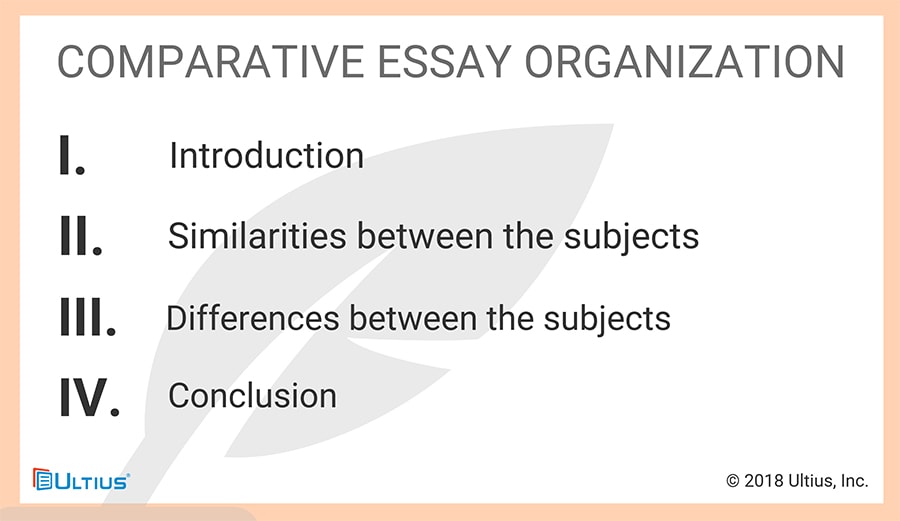
In the second format, both similarities and differences would be considered within each of the parameter sections.
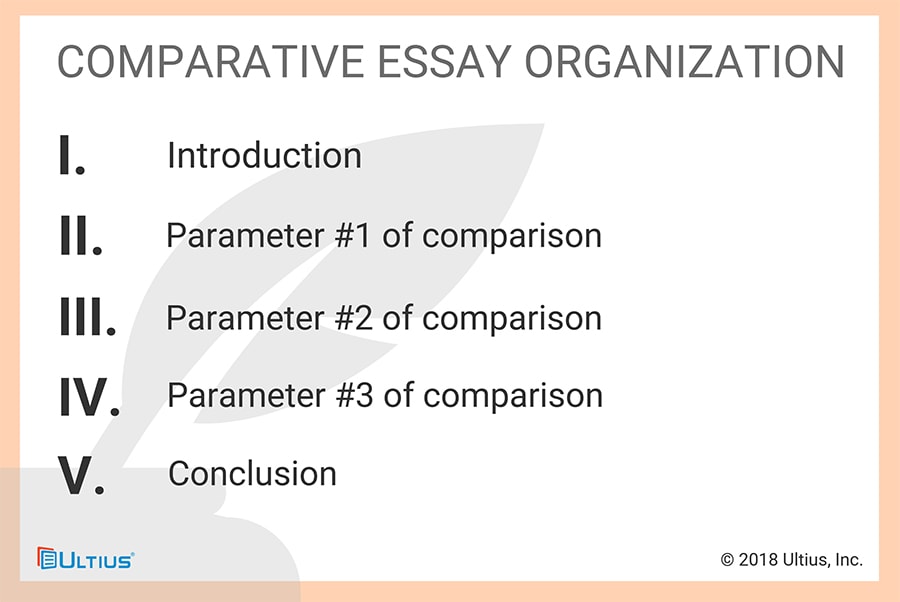
Both these are formats are good, and a strong comparative essay could be built around either one.
The important thing is to have a clear system and to not make your comparisons random.
There needs to be an organizational structure that your reader can easily follow.
There are steps you can follow in order to ensure that your comparative essay has all the elements that will be required in order to make it great.
Ask yourself about your intention
If you have selected two items for your comparative essay, then you should start by asking yourself why you selected those two items. What is it about the two items that made you think it would be a good idea to compare them? (Or if you were assigned the two items, then why do you think those items were selected by your professor?)
The point here is that the items selected for a comparative essay are non-random. They are selected because that specific comparison should be able to yield interesting insights (unlike research papers ).
For example, if you are writing a comparative essay on the dogs vs. cats, then are you writing this from the perspective of evolutionary biology? Or are you perhaps writing it in order to inform potential pet owners who are debating whether they want a dog or a cat?
The purpose of your essay will determine what parameters you will select in order to compare your two items. This means that you should have an intended audience in mind, and you should also have specific questions you would like to know more about.
In short, in order to develop effective parameters for your comparative essay, you have to ask yourself why you are writing it and who would be interested in the insights produced by the essay. This can help ensure you select both appropriate items and appropriate parameters for comparison.
Develop a structural outline
It is very important that you do not just jump into your comparative essay and start writing it without a plan. That is a recipe for disaster, and the comparisons will almost certainly turn out random and confusing. Rather, you should begin with a solid outline .
A good outline will do three main things:
- 1. Identify the selected items of comparison in the introduction/thesis
- 2. Utilize one of the two organizational formats described above
- 3. Provide a roadmap for how you intend to systematically follow through on the comparison
For example, here is how an outline could look for a comparative essay on Romanticism vs. the Enlightenment.
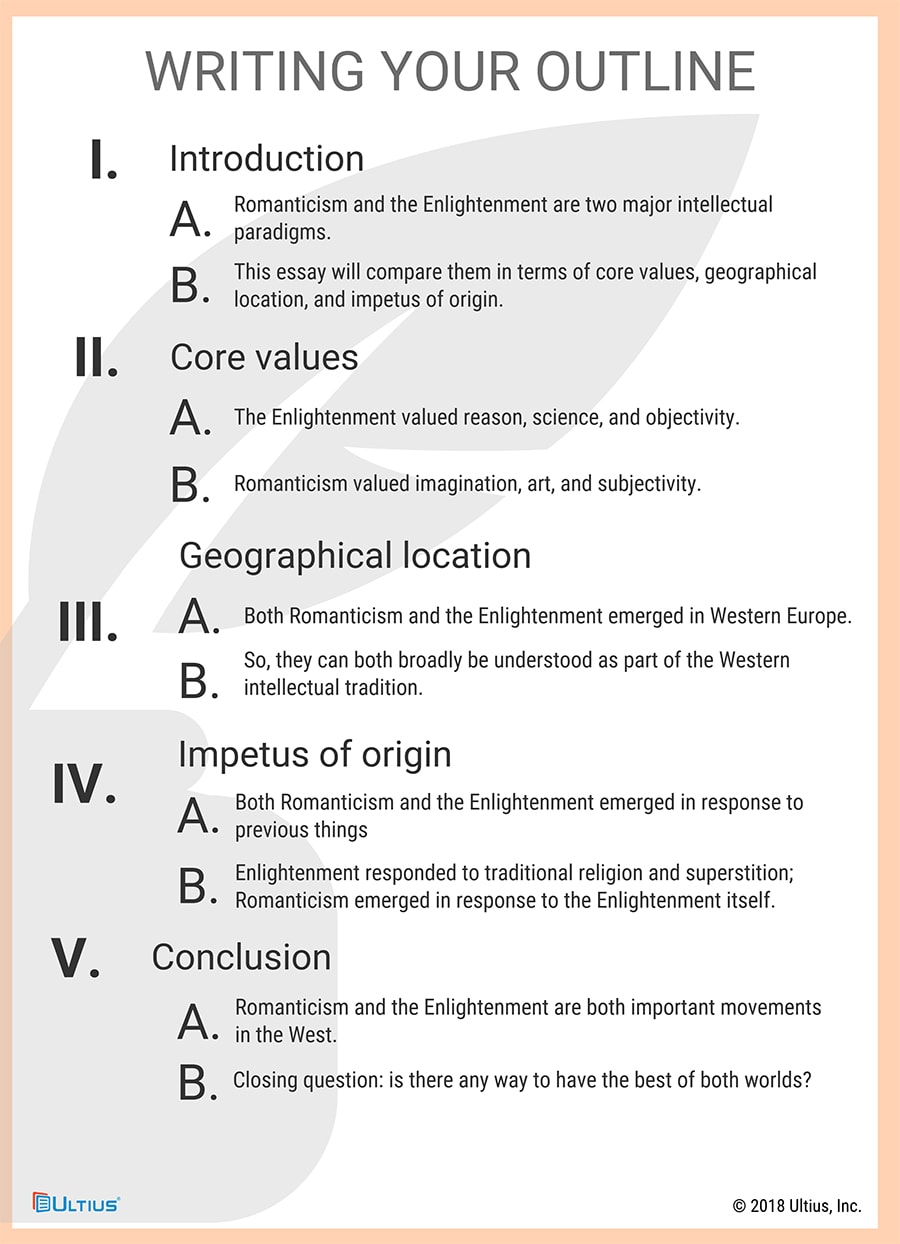
In this sample outline, the format that is used dedicates a paragraph to each of three parameters of comparison, and both similarities and differences are addressed for each of those parameters.
This is the kind of logical flow that you will need to have in order for your comparative essay to turn out great.
Write in a systematic way
A comparative essay is not a place to get too creative with your writing, whether in terms of organization or in terms of style.
Rather, you should focus on simply carrying out your comparison, point-by-point and in a way that is easy for your reader to follow. This can get a little tedious, so if that is a problem for you, then you should make sure that you set aside enough time to work on your comparative essay little by little.
For example, if your essay has three parameters, then you could write a section on the first parameter today, the second parameter tomorrow, and the third parameter the next day.
The important thing is for you to ensure that you consider each of your two selected items in terms of each of your selected parameters. This needs to be done in a smooth and logical manner, such that your reader knows where you are in the comparison. There should be no jumping around, and there should be no departure from the basic format or structure.
Example comparative (compare/contrast) essay
Best practices/tips.
We have now arrived at the end of this guide, and you should have a much better idea of what makes a comparative essay successful and how you can go about writing one. It may be helpful to now summarize some of the main points that have been addressed here.
Let's address five main points.
1. Ensure that you select appropriate items for comparison
The two items that will be compared in your comparative essay should be carefully selected. The items should have some shared features and be in the same "class" of items, but they should also have substantial differences to which you are trying to call attention. If the items are too similar, then there would be no point in the comparison, but if they are too different, that can also make the comparison meaningless.
2. Select effective parameters of comparison
Your comparative essay shouldn't compare anything and everything between your two items; rather, the parameters should be specifically selected to highlight specific, salient similarities and differences. In order to determine what parameters would be effective, you have to ask yourself why you are writing your comparative essay and what sort of insights you intend to produce about the items being compared.
3. Use tools and models in an effective way
The Venn diagram is one tool that can be very helpful in conceptualizing your comparative essay, especially if you are a more visual kind of learner. Tables, rubrics, and outlines will also work to help ensure that you are developing a strong backbone of logic and systematic reasoning for your comparative essay. These and other tools may even help you reconsider your initial choices of items and parameters, if you realize that significant insights are not being produced.
4. Choose an organizational format, and stick with it
There are two main ways in which to structure an effective comparative essay, which have been described above. You can dedicate one section to similarities and one section to differences; or, you can dedicate a section to each of the parameters of comparison. This second option is usually more effective, especially if you are new to comparative essays. But either way, it is crucial that you stick to your chosen format and do not jump around and confuse the reader.
5. Seek assistance if you need it
If you are still uncertain about how to write a successful comparative essay, then Ultius is here to help. Our writer help section has many tools like this one available on various types of essays; we have a huge writer help section that contains all sorts of information on pretty much any writing-related questions you may have; and we also have elite professional writers who can produce a sample comparative essay for you on any subject of your choosing. We are here for you, and if you have any further questions about how to write a comparative essay, then you should feel free to reach out.

Tested Daily
Click to Verify
About The Author
This post was written by Ultius.

The Ultius Promise
With every order, you can count on the following:
- Delivered on time
- 100% original
- Free revisions
- Awesome 24/7 support
- World-class writers
- Writer Options
- Custom Writing
- Business Documents
- Support Desk
- +1-800-405-2972
- Submit bug report
- A+ BBB Rating!
Ultius is the trusted provider of content solutions for consumers around the world. Connect with great American writers and get 24/7 support.
© 2024 Ultius, Inc.
- Refund & Cancellation Policy
Free Money For College!
Yeah. You read that right —We're giving away free scholarship money! Our next drawing will be held soon.
Our next winner will receive over $500 in funds. Funds can be used for tuition, books, housing, and/or other school expenses. Apply today for your chance to win!
* We will never share your email with third party advertisers or send you spam.
** By providing my email address, I am consenting to reasonable communications from Ultius regarding the promotion.
Past winner

- Name Samantha M.
- From Pepperdine University '22
- Studies Psychology
- Won $2,000.00
- Award SEED Scholarship
- Awarded Sep. 5, 2018
Thanks for filling that out.
Check your inbox for an email about the scholarship and how to apply.
How To Structure A Comparative Essay (VCE English Tips)
What is a comparative essay.
The comparative essay, in only its second year of being on the VCE English syllabus, is a cause for confusion for many students and teachers alike. Read on for one simple way to structure a comparative essay.
Comparative essay structure
How to write an introduction for a comparative essay.
This can be structured in much the same way as a text response essay. Here, the only difference is that you will need to introduce both texts. Do not forget to make use of comparative language, which is an element of the VCAA criteria, which requires that students discuss "meaningful connections , similarities or differences between the texts”. Your introduction must address your overall contention, specific to the prompt, which should be an idea or concept running through your essay.
How to write a body paragraph for a comparative essay
Aim for around two to four body paragraphs, which should be developed using breadth and a wide scope of ideas. A good way to construct these paragraphs is to base each around a premise or main idea, and you will explore both texts through the lens of this premise.
You can choose either to compare both texts throughout the paragraph, or to go into depth in one text and then transition into exploring the other. No matter which method you choose, make you mention to which extent the two texts are similar or different (it's not enough to say "they are different" or "they are similar").
Relate the end of your body paragraph back to the overall contention, bringing both texts explicitly into focus.
How to write a conclusion for a comparative essay
Like the intro, this can be very similar to a text response conclusion! Make sure to be clear and concise, and sum up your main points from your body paragraphs. Aim to end with a strong, clear point of analysis, shining new meaning on both texts.
Comparative Essay Writing Tips
- Create an Outline: Develop a well-organised outline to keep your essay focused and ensure a logical flow of arguments. This framework serves as a roadmap, guiding you from one point to the next. Always connect your arguments back to your thesis statement for coherence.
- Reference Throughout the Process: Avoid last-minute referencing by incorporating it into your writing process. Cite sources as you go to maintain accuracy and credibility. This practice helps in seamlessly integrating evidence to support your comparisons.
- Highlight Differences and Similarities: Emphasise both differences and similarities between the subjects you're comparing. Provide a clear analysis of how they relate, diverge, or intersect. This enhances the depth of your comparison and adds richness to your essay.
- Utilise Concrete Examples: Enhance the persuasiveness of your writing by using specific examples. Illustrate your points with concrete instances that support your comparisons. This not only reinforces your arguments but also adds clarity to your overall narrative.
- Incorporate Comparative Vocabulary: make sure your essay contains appropriate terminology and comparative words, such as: "On the contrary," "Although," "Furthermore," "Similar to," "Unlike," "In the same way," "Likewise," "Compared to," "In contrast," "Yet," and "On the one hand...on the other hand."
- Collaborate for Improvement: Seek input from others, whether through an English tutor or a study group. Collaborating with peers can provide valuable insights and help refine your work. Different perspectives contribute to a more comprehensive and polished essay.
- Prioritise Drafting: Aim to draft your essay as early as possible. Getting your initial thoughts on paper makes the editing process more manageable. Remember, a first draft is easier to edit than starting with a blank page
- Proofread and Edit: Finally, proofread and edit your essay. Pay attention to grammar, spelling, and overall clarity. A well-polished essay enhances the overall impact of your comparative analysis.
If you loved this article, you will LOVE all of our other articles, such as: How To Take Notes To Maximise Success , 2U Maths Tips from a Past Student (98 in 2U Maths)! and Tips on Studying for Exams – Learnmate Tutoring .
About Learnmate
Learnmate is a trusted Australian community platform that connects students who want 1:1 or small group study support, with tutors who are looking to share their knowledge and earn an income. From primary school to high school subjects — from science and maths to niche subjects like visual communication — Learnmate can help you improve academic performance or boost confidence, at your pace with the tutor that you choose.
We pride ourselves in offering a reliable and positive experience for both our students and tutors. Every tutor that joins the platform is vetted to meet a level of academic excellence, teaching qualification or relevant experience. All tutors are provided the opportunity to complete professional training.
Students and parents can easily find and screen for tutors based on their location, their subject results or skill level, and whether they provide in-person or online sessions. Learnmate is proud to provide tutors in Melbourne , Sydney , Geelong , Brisbane , Hobart , Canberra , Perth & Adelaide , and other locations.
Learnmate also has tutors for all curriculums: HSC , IB , QCE , BSSS, SACE , TASC, WACE , VCE and UMAT
Go online and let Learnmate help you get ahead. Start your search today.
"> "> share this post.
Article Author
Find online & in-person tutors near you, recent posts.

VCE SACs: Maximising Your Scores and Understanding Their Impact
Mastering VCE SACs: A Comprehensive Guide As part of the Victorian Certificate of Education (VCE), School Assessed Coursework (SACs) are...
March 26, 2024

Understanding Liquidity Analysis in VCE Accounting: Part One
In the latter part of the VCE Accounting course, students focus extensively on evaluating the financial performance of businesses. An...

Understanding Composite Functions in VCE Maths Methods: A Guide to Understanding and Applying Them
Hi there! My name is Daniela and I am a VCE Math Methods and Biology tutor on Learnmate. I graduated...
March 13, 2024


+61 481607654

Writing a Comparative Essay: Importance, Elements and Topic Suggestion
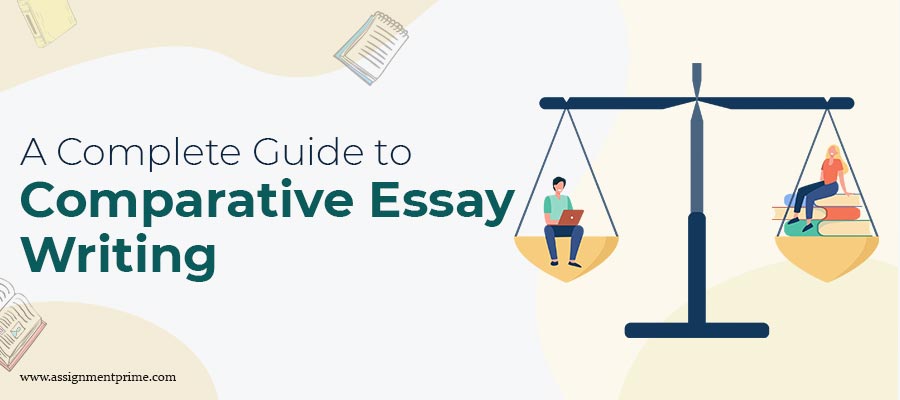
Table Of Contents
Introduction to the concept of comparative essay, importance of comparative essays, elements to write a good comparative essay, how to write a comparative essay introduction, how to write a conclusion for a comparative essay, 10 trending topics for comparative essay, who can write a comparative essay for me.
An essay is a write-up that we have been doing since our school time. It is a document where one can express his thoughts on a topic by giving the facts and figures to support his argument. It is based on the analysis and interpretation of the writer.
An essay is divided into different categories; therefore, it is important to know the type of essay you are writing according to your thoughts. The types of essay are:
- Comparative Essay
- Descriptive Essay
- Narrative Essay
- Cause and Effect Essay
- Process Essay
- Expository Essay
- Persuasive Essay
Further, we will talk about the concept of a Comparative essay. Read more to understand the bigger picture.
In a comparative essay, there are two subjects in a topic that are compared to have clarity and detailed information on each subject. It helps in examining the two subjects of the topic differently to know its similarities and the facts that prove them different from each other.
Every writer has their perspective and approach which makes it an insightful process of writing a comparative essay. The different approach of every writer helps understand a broader image of the argument.
A comparative essay is important to understand the difference and similarities between the two subjects that are compared in the argument. It gives a detailed idea of the topic where each subject is defined in a broader way showcasing their nature and properties.
It requires excellent thinking skills to approach the topic, make an argument, and give evidence such as facts and figures to support the information.
- Detailed Information on Similarities and Differences: Comparative essay helps in understanding the properties of the two compared subjects. It shows the similarities and comparisons between the two to have a proper understanding of the topic.
- Clarity of Information: With the help of a detailed study of the subject, it provides concrete information supporting the idea of the central argument or thesis statement of the essay.
- Helps in Decision Making: By analyzing the two compared subjects, with facts and figures in a detailed manner, helps in decision making to knowing which side to be agreed upon. It shows both the positive and negative sides by comparing the two subjects which makes it easier while making any decisions.
The above points show the importance of a Comparative Essay. Now let us discuss the elements required for a good essay.
If you are writing a comparative essay, the following are the points you should remember to make it an easy process for you. These are used in the essay that requires text response through an analytical approach. They are:
- Select a Topic to Compare: The first step is to select two subjects to compare in the topic. It will help in the right type of research and design the outline of the essay accordingly.
- Follow a Structure: The basic approach of essay writing which includes introduction, body, and conclusion is known to all. It helps the reader in the step-by-step understanding of the information. Also, makes an essay organized and presentable.
- Prepare Outline of the Structure: Structural outline helps in the planning of an essay and the topics required to be covered in the essay. It helps in brainstorming the ideas, note them on a paper, and organizing it step-by-step. It helps in a better understanding of the topic without losing the interest of the reader.
- Parameters of Comparison: A good comparative essay must include two good subjects to be compared as well as parameters on which they are compared. The parameters must be selected that interest the readers to learn the detailed insights on the same.
- Relativeness and Comparison of Two Subjects: Research can show differences between the two selected subjects or it can also result in defining some of the other factors that make them relatively similar.
In the next section, you will learn how to write an attractive introduction to hold the reader's interest throughout the essay. Whereas, the body can be written using two approaches: block approach and woven approach. The conclusion part is also covered in the different sections of this blog, where you will be able to make the conclusion impactful for the readers.
The introduction plays a major role in engaging the reader's attention; therefore, it has to be very attractive to make the reader go through the essay till the end.
The following are the points to make an essay introduction attractive:
- Prepare a Central Statement: A central statement shows the purpose of the essay. It helps the reader understand the gist of the essay and the writer's thought process is reflected through the central statement.
- Show the Importance of the Topic: The importance of the topic needs to be specific to know the reason behind choosing the topic and the importance it creates for people.
- Start with a Short Background: A little story is what interests people therefore, an introduction can be started with a short story showcasing the topic details.
- Appropriate Transitions: An essay is written in paragraphs giving details step-by-step. Therefore, appropriate transition plays an important role in a proper understanding of the information.
- Facts and Figures to Support Details: Always support the argument with relevant facts and figures as evidence to make the argument strong.
- Similarities and Differences: In a comparative essay, it is important to specify both similarities and differences to provide information that can help the reader make a judgment.
The conclusion is the closure of the essay; therefore, it must convey the sense of completeness and clarity of the essay. The conclusion is what makes the research worth stating the learning from the research. It shows the outcome of the research by answering the question of the essay.
Remember to not contradict your statement or any information that has been there in the body of the essay. It may result in the unclear thought process of the writer and lead to the loss of the reader’s interest.
The following points must be included in the conclusion for a good closure of the essay:
1. Summarize with the Focused Points: Make sure to include all the major points while summarizing the essay. It will show the gist of the essay and what will be the understanding of the reader from the essay.
The summary must be concise and clear. A summary of the main points will help eliminate the irrelevant information and focus on the main idea of the essay. It should create an impact on the reader that the above essay is worth reading and will provide some well-researched information.
2. Prove That the Central Statement Is Answered: It is important to include relevant information in the conclusion as it is a concise written draft. Therefore, showing that the central statement is important as it is the main idea of the argument should necessarily be answered to make an essay relevant.
By focusing on the main points, the central statement must be answered in the same. It will show the relevancy of the content and generate readers' attention.
3. Question ending: The ending of the essay can be a question for the readers that will make them think even after finishing the write-up. It is the best strategy to hold the interest of the reader and let the ending be remembered.
A question ends will let the reader wait for the next essay to clear his doubts or research on the topic. The reader will also be able to think and have his perspective on the topic that makes impactful writing.
A comparative essay can be written on any of the two items of the same category. The following is the list of the top 10 trending topics of 2021 for a comparative essay:
- Picking the right discipline and success in career
- Virtual classrooms and real classrooms
- Netflix or amazon prime
- IOS or android
- Presence on social media: yes or no
- Machine learning or IoT
- Political disruption and economic rise
- Freedom of expression and constraint on freedom
- What is more productive: studying at home or studying in a library?
- MNC employee and employee from a small organization
The perfect solution for your poor writing skills is right here! Now is not the time to struggle with your write-ups when you have the advantage of getting professional writers to do your job.
The task of a comparative essay can take so much time in research work to compare the subjects and give a learning experience to the readers. If you do not want the stress of the process, then you can contact Assignment Prime , one of the leading professional academic writing service providers for the same.
With a team of highly experienced professionals, we understand the need of students at the last hour and are ready to help you then also. The services they provide will let you sit back and relax while your comparative essay is in the process of completion by expert writers.
- Money-back Guarantee
- No Plagiarized Content
- Timely Delivery
- Certified Writers
- 24*7 Assistance
- Plagiarism Report
- Unlimited Revisions
Hurry up! Place your essay order today to achieve the grades of your dreams.
You may also like:
How to Write a Reflective Essay? | Let Your Words Describe Your Glory
How to Choose a Good Argumentative Essay Topic? 100+ Best Ideas to Help You
Handwriting is a Photograph of Our Psyche

To Make Your Work Original
Check your work against paraphrasing & get a free Plagiarism report!
Check your work against plagiarism & get a free Plagiarism report!
Get citations & references in your document in the desired style!
Make your content free of errors in just a few clicks for free!
Generate plagiarism-free essays as per your topic’s requirement!
FREE Features
- Topic Creation USD 4.04 FREE
- Outline USD 9.75 FREE
- Unlimited Revisions USD 21.6 FREE
- Editing/Proofreading USD 29.26 FREE
- Formatting USD 8.36 FREE
- Bibliography USD 7.66 FREE
Get all these features for
USD 84.3 FREE
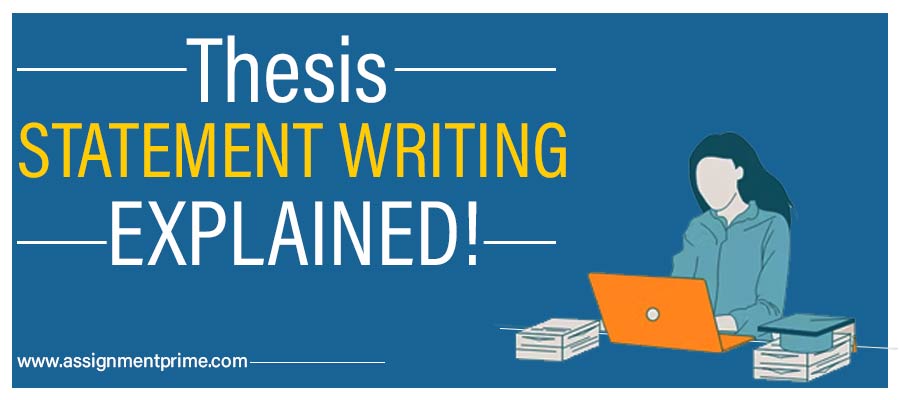
Thesis Statement Writing: How Crucial is it? How to Write? & More
![example conclusion for comparative essay All About Short Essay Writing [Examples Included]](https://www.assignmentprime.com/images/AP_Blog_Image_How_to_Write_a_Short_Essay.jpg)
All About Short Essay Writing [Examples Included]
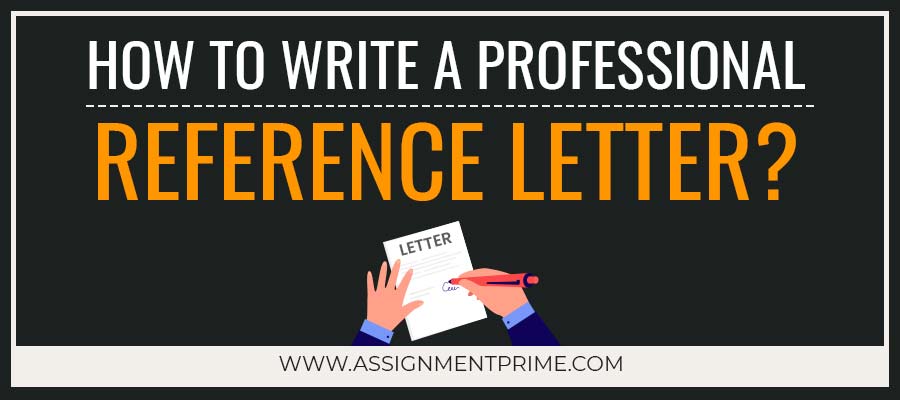
How to Write a Letter of Reference with Templates?

Experts' Guidance on How to Conduct Nike’s SWOT Analysis

Avail the Best Assignment Writing Services in Just One Tap!
Add "5% extra off on app"
We use cookies to ensure that we give you the best experience on our website. If you continue to use this site we will assume that you are happy with it. Know more

Please rotate your device
We don't support landscape mode yet. Please go back to portrait mode for the best experience
Have a language expert improve your writing
Run a free plagiarism check in 10 minutes, generate accurate citations for free.
- Knowledge Base
- How to conclude an essay | Interactive example
How to Conclude an Essay | Interactive Example
Published on January 24, 2019 by Shona McCombes . Revised on July 23, 2023.
The conclusion is the final paragraph of your essay . A strong conclusion aims to:
- Tie together the essay’s main points
- Show why your argument matters
- Leave the reader with a strong impression
Your conclusion should give a sense of closure and completion to your argument, but also show what new questions or possibilities it has opened up.
This conclusion is taken from our annotated essay example , which discusses the history of the Braille system. Hover over each part to see why it’s effective.
Braille paved the way for dramatic cultural changes in the way blind people were treated and the opportunities available to them. Louis Braille’s innovation was to reimagine existing reading systems from a blind perspective, and the success of this invention required sighted teachers to adapt to their students’ reality instead of the other way around. In this sense, Braille helped drive broader social changes in the status of blindness. New accessibility tools provide practical advantages to those who need them, but they can also change the perspectives and attitudes of those who do not.
Instantly correct all language mistakes in your text
Upload your document to correct all your mistakes in minutes

Table of contents
Step 1: return to your thesis, step 2: review your main points, step 3: show why it matters, what shouldn’t go in the conclusion, more examples of essay conclusions, other interesting articles, frequently asked questions about writing an essay conclusion.
To begin your conclusion, signal that the essay is coming to an end by returning to your overall argument.
Don’t just repeat your thesis statement —instead, try to rephrase your argument in a way that shows how it has been developed since the introduction.
Prevent plagiarism. Run a free check.
Next, remind the reader of the main points that you used to support your argument.
Avoid simply summarizing each paragraph or repeating each point in order; try to bring your points together in a way that makes the connections between them clear. The conclusion is your final chance to show how all the paragraphs of your essay add up to a coherent whole.
To wrap up your conclusion, zoom out to a broader view of the topic and consider the implications of your argument. For example:
- Does it contribute a new understanding of your topic?
- Does it raise new questions for future study?
- Does it lead to practical suggestions or predictions?
- Can it be applied to different contexts?
- Can it be connected to a broader debate or theme?
Whatever your essay is about, the conclusion should aim to emphasize the significance of your argument, whether that’s within your academic subject or in the wider world.
Try to end with a strong, decisive sentence, leaving the reader with a lingering sense of interest in your topic.
The easiest way to improve your conclusion is to eliminate these common mistakes.
Don’t include new evidence
Any evidence or analysis that is essential to supporting your thesis statement should appear in the main body of the essay.
The conclusion might include minor pieces of new information—for example, a sentence or two discussing broader implications, or a quotation that nicely summarizes your central point. But it shouldn’t introduce any major new sources or ideas that need further explanation to understand.
Don’t use “concluding phrases”
Avoid using obvious stock phrases to tell the reader what you’re doing:
- “In conclusion…”
- “To sum up…”
These phrases aren’t forbidden, but they can make your writing sound weak. By returning to your main argument, it will quickly become clear that you are concluding the essay—you shouldn’t have to spell it out.
Don’t undermine your argument
Avoid using apologetic phrases that sound uncertain or confused:
- “This is just one approach among many.”
- “There are good arguments on both sides of this issue.”
- “There is no clear answer to this problem.”
Even if your essay has explored different points of view, your own position should be clear. There may be many possible approaches to the topic, but you want to leave the reader convinced that yours is the best one!
- Argumentative
- Literary analysis
This conclusion is taken from an argumentative essay about the internet’s impact on education. It acknowledges the opposing arguments while taking a clear, decisive position.
The internet has had a major positive impact on the world of education; occasional pitfalls aside, its value is evident in numerous applications. The future of teaching lies in the possibilities the internet opens up for communication, research, and interactivity. As the popularity of distance learning shows, students value the flexibility and accessibility offered by digital education, and educators should fully embrace these advantages. The internet’s dangers, real and imaginary, have been documented exhaustively by skeptics, but the internet is here to stay; it is time to focus seriously on its potential for good.
This conclusion is taken from a short expository essay that explains the invention of the printing press and its effects on European society. It focuses on giving a clear, concise overview of what was covered in the essay.
The invention of the printing press was important not only in terms of its immediate cultural and economic effects, but also in terms of its major impact on politics and religion across Europe. In the century following the invention of the printing press, the relatively stationary intellectual atmosphere of the Middle Ages gave way to the social upheavals of the Reformation and the Renaissance. A single technological innovation had contributed to the total reshaping of the continent.
This conclusion is taken from a literary analysis essay about Mary Shelley’s Frankenstein . It summarizes what the essay’s analysis achieved and emphasizes its originality.
By tracing the depiction of Frankenstein through the novel’s three volumes, I have demonstrated how the narrative structure shifts our perception of the character. While the Frankenstein of the first volume is depicted as having innocent intentions, the second and third volumes—first in the creature’s accusatory voice, and then in his own voice—increasingly undermine him, causing him to appear alternately ridiculous and vindictive. Far from the one-dimensional villain he is often taken to be, the character of Frankenstein is compelling because of the dynamic narrative frame in which he is placed. In this frame, Frankenstein’s narrative self-presentation responds to the images of him we see from others’ perspectives. This conclusion sheds new light on the novel, foregrounding Shelley’s unique layering of narrative perspectives and its importance for the depiction of character.
If you want to know more about AI tools , college essays , or fallacies make sure to check out some of our other articles with explanations and examples or go directly to our tools!
- Ad hominem fallacy
- Post hoc fallacy
- Appeal to authority fallacy
- False cause fallacy
- Sunk cost fallacy
College essays
- Choosing Essay Topic
- Write a College Essay
- Write a Diversity Essay
- College Essay Format & Structure
- Comparing and Contrasting in an Essay
(AI) Tools
- Grammar Checker
- Paraphrasing Tool
- Text Summarizer
- AI Detector
- Plagiarism Checker
- Citation Generator
Your essay’s conclusion should contain:
- A rephrased version of your overall thesis
- A brief review of the key points you made in the main body
- An indication of why your argument matters
The conclusion may also reflect on the broader implications of your argument, showing how your ideas could applied to other contexts or debates.
For a stronger conclusion paragraph, avoid including:
- Important evidence or analysis that wasn’t mentioned in the main body
- Generic concluding phrases (e.g. “In conclusion…”)
- Weak statements that undermine your argument (e.g. “There are good points on both sides of this issue.”)
Your conclusion should leave the reader with a strong, decisive impression of your work.
The conclusion paragraph of an essay is usually shorter than the introduction . As a rule, it shouldn’t take up more than 10–15% of the text.
Cite this Scribbr article
If you want to cite this source, you can copy and paste the citation or click the “Cite this Scribbr article” button to automatically add the citation to our free Citation Generator.
McCombes, S. (2023, July 23). How to Conclude an Essay | Interactive Example. Scribbr. Retrieved April 3, 2024, from https://www.scribbr.com/academic-essay/conclusion/
Is this article helpful?
Shona McCombes
Other students also liked, how to write an essay introduction | 4 steps & examples, how to write a thesis statement | 4 steps & examples, example of a great essay | explanations, tips & tricks, what is your plagiarism score.
So much is at stake in writing a conclusion. This is, after all, your last chance to persuade your readers to your point of view, to impress yourself upon them as a writer and thinker. And the impression you create in your conclusion will shape the impression that stays with your readers after they've finished the essay.
The end of an essay should therefore convey a sense of completeness and closure as well as a sense of the lingering possibilities of the topic, its larger meaning, its implications: the final paragraph should close the discussion without closing it off.
To establish a sense of closure, you might do one or more of the following:
- Conclude by linking the last paragraph to the first, perhaps by reiterating a word or phrase you used at the beginning.
- Conclude with a sentence composed mainly of one-syllable words. Simple language can help create an effect of understated drama.
- Conclude with a sentence that's compound or parallel in structure; such sentences can establish a sense of balance or order that may feel just right at the end of a complex discussion.
To close the discussion without closing it off, you might do one or more of the following:
- Conclude with a quotation from or reference to a primary or secondary source, one that amplifies your main point or puts it in a different perspective. A quotation from, say, the novel or poem you're writing about can add texture and specificity to your discussion; a critic or scholar can help confirm or complicate your final point. For example, you might conclude an essay on the idea of home in James Joyce's short story collection, Dubliners , with information about Joyce's own complex feelings towards Dublin, his home. Or you might end with a biographer's statement about Joyce's attitude toward Dublin, which could illuminate his characters' responses to the city. Just be cautious, especially about using secondary material: make sure that you get the last word.
- Conclude by setting your discussion into a different, perhaps larger, context. For example, you might end an essay on nineteenth-century muckraking journalism by linking it to a current news magazine program like 60 Minutes .
- Conclude by redefining one of the key terms of your argument. For example, an essay on Marx's treatment of the conflict between wage labor and capital might begin with Marx's claim that the "capitalist economy is . . . a gigantic enterprise of dehumanization "; the essay might end by suggesting that Marxist analysis is itself dehumanizing because it construes everything in economic -- rather than moral or ethical-- terms.
- Conclude by considering the implications of your argument (or analysis or discussion). What does your argument imply, or involve, or suggest? For example, an essay on the novel Ambiguous Adventure , by the Senegalese writer Cheikh Hamidou Kane, might open with the idea that the protagonist's development suggests Kane's belief in the need to integrate Western materialism and Sufi spirituality in modern Senegal. The conclusion might make the new but related point that the novel on the whole suggests that such an integration is (or isn't) possible.
Finally, some advice on how not to end an essay:
- Don't simply summarize your essay. A brief summary of your argument may be useful, especially if your essay is long--more than ten pages or so. But shorter essays tend not to require a restatement of your main ideas.
- Avoid phrases like "in conclusion," "to conclude," "in summary," and "to sum up." These phrases can be useful--even welcome--in oral presentations. But readers can see, by the tell-tale compression of the pages, when an essay is about to end. You'll irritate your audience if you belabor the obvious.
- Resist the urge to apologize. If you've immersed yourself in your subject, you now know a good deal more about it than you can possibly include in a five- or ten- or 20-page essay. As a result, by the time you've finished writing, you may be having some doubts about what you've produced. (And if you haven't immersed yourself in your subject, you may be feeling even more doubtful about your essay as you approach the conclusion.) Repress those doubts. Don't undercut your authority by saying things like, "this is just one approach to the subject; there may be other, better approaches. . ."
Copyright 1998, Pat Bellanca, for the Writing Center at Harvard University
Ultimate Guide to Writing Your College Essay
Tips for writing an effective college essay.
College admissions essays are an important part of your college application and gives you the chance to show colleges and universities your character and experiences. This guide will give you tips to write an effective college essay.
Want free help with your college essay?
UPchieve connects you with knowledgeable and friendly college advisors—online, 24/7, and completely free. Get 1:1 help brainstorming topics, outlining your essay, revising a draft, or editing grammar.
Writing a strong college admissions essay
Learn about the elements of a solid admissions essay.
Avoiding common admissions essay mistakes
Learn some of the most common mistakes made on college essays
Brainstorming tips for your college essay
Stuck on what to write your college essay about? Here are some exercises to help you get started.
How formal should the tone of your college essay be?
Learn how formal your college essay should be and get tips on how to bring out your natural voice.
Taking your college essay to the next level
Hear an admissions expert discuss the appropriate level of depth necessary in your college essay.
Student Stories
Student Story: Admissions essay about a formative experience
Get the perspective of a current college student on how he approached the admissions essay.
Student Story: Admissions essay about personal identity
Get the perspective of a current college student on how she approached the admissions essay.
Student Story: Admissions essay about community impact
Student story: admissions essay about a past mistake, how to write a college application essay, tips for writing an effective application essay, sample college essay 1 with feedback, sample college essay 2 with feedback.
This content is licensed by Khan Academy and is available for free at www.khanacademy.org.
Home — Essay Samples — Science — Agriculture — Maya vs. Inca: A Comparative Analysis
Maya Vs. Inca: a Comparative Analysis
- Categories: Agriculture
About this sample

Words: 1236 |
Published: Mar 25, 2024
Words: 1236 | Pages: 3 | 7 min read

Cite this Essay
Let us write you an essay from scratch
- 450+ experts on 30 subjects ready to help
- Custom essay delivered in as few as 3 hours
Get high-quality help

Verified writer
- Expert in: Science

+ 120 experts online
By clicking “Check Writers’ Offers”, you agree to our terms of service and privacy policy . We’ll occasionally send you promo and account related email
No need to pay just yet!
Related Essays
1 pages / 422 words
2 pages / 937 words
4 pages / 2014 words
2 pages / 1033 words
Remember! This is just a sample.
You can get your custom paper by one of our expert writers.
121 writers online
Still can’t find what you need?
Browse our vast selection of original essay samples, each expertly formatted and styled
Related Essays on Agriculture
Agriculture triggered a significant change in the society. For many years, people used to hunt and gather food from the local environment. They depended on plants and animals provided by nature. Farming was invented around 200 [...]
The Southern Colonies in America were characterized by a warm and humid climate, which greatly influenced the development of the region. This essay will analyze the climate of the Southern Colonies, exploring its impact on the [...]
Monsanto, a multinational agrochemical and agricultural biotechnology corporation, has been the center of controversy and debate for decades. The company has faced accusations of promoting genetically modified organisms (GMOs) [...]
In conclusion, technology plays a pivotal role in addressing the challenges posed by overpopulation. Advancements in agriculture, medicine, and urban planning have the potential to mitigate the effects of overpopulation and [...]
Odurukwe, S., Matthews-Njoku, E., & Ejioku-Okereke, N. (2006). Agricultural production and poverty in Nigeria. Journal of Rural Economics and Development, 15(1), 32-45.Food and Agriculture Organization (FAO). (1995). [...]
We have discussed agriculture and it’s changes over the past two-hundred years. Compare the population 1900 to today for Texas, United States, And World. Today, i will tell you about comparing the population from 1900 to today [...]
Related Topics
By clicking “Send”, you agree to our Terms of service and Privacy statement . We will occasionally send you account related emails.
Where do you want us to send this sample?
By clicking “Continue”, you agree to our terms of service and privacy policy.
Be careful. This essay is not unique
This essay was donated by a student and is likely to have been used and submitted before
Download this Sample
Free samples may contain mistakes and not unique parts
Sorry, we could not paraphrase this essay. Our professional writers can rewrite it and get you a unique paper.
Please check your inbox.
We can write you a custom essay that will follow your exact instructions and meet the deadlines. Let's fix your grades together!
Get Your Personalized Essay in 3 Hours or Less!
We use cookies to personalyze your web-site experience. By continuing we’ll assume you board with our cookie policy .
- Instructions Followed To The Letter
- Deadlines Met At Every Stage
- Unique And Plagiarism Free

IMAGES
VIDEO
COMMENTS
What is a Comparative Essay? A compare and contrast essay, also known as a comparison essay, talks about how two ideas or objects differ and how they are similar. Some essays may only talk about similarities, while others may only talk about differences. This focus depends on the length and scope of the essay. An example of a topic for a compare and contrast essay is a comparison between life ...
Essay Conclusion Examples. Below is a range of copy-and-paste essay conclusions with gaps for you to fill-in your topic and key arguments. Browse through for one you like (there are 17 for argumentative, expository, compare and contrast, and critical essays). ... Through this comparative analysis, a broader understanding of macrosociology and ...
Moreover, a comparative analysis essay discusses the similarities and differences of themes, items, events, views, places, concepts, etc. For example, you can compare two different novels (e.g., The Adventures of Huckleberry Finn and The Red Badge of Courage). However, a comparative essay is not limited to specific topics.
The block method. In the block method, you cover each of the overall subjects you're comparing in a block. You say everything you have to say about your first subject, then discuss your second subject, making comparisons and contrasts back to the things you've already said about the first. Your text is structured like this: Subject 1.
The conclusion of a comparative paper drives home your main points by restating key similarities and differences. You get a chance to emphasize why comparing the two ideas matters and what readers should take from the piece. ... In the conclusion, rephrase it and pull some of the points from the essay. An example is, "Students and employees ...
This handout will help you first to determine whether a particular assignment is asking for comparison/contrast and then to generate a list of similarities and differences, decide which similarities and differences to focus on, and organize your paper so that it will be clear and effective. It will also explain how you can (and why you should ...
Comparative Essays. ... For example, a comparative essay using the block method on the French and Russian revolutions would address the French Revolution in the first half of the essay and the Russian Revolution in the second half. If you choose the block method, however, make sure they are connected! The B block should refer to the A block and ...
1. Begin by Brainstorming With a Venn Diagram. The best compare and contrast essays demonstrate a high level of analysis. This means you will need to brainstorm before you begin writing. A Venn diagram is a great visual tool for brainstorming compare and contrast essay topics.
For example, a comparative essay using the block method on the French and Russian revolutions would address the French Revolution in the first half of the essay and the Russian Revolution in the second half. If you choose the block method, however, do not simply append two disconnected essays to an introductory thesis.
The conclusion of a compare-and-contrast essay states a strong position and encourages the reader to agree with the writer's points. > ... For example, if comparing theme in two pieces of literature, you would include some evaluation in the thesis statement: "By indulging in hyperbole, the poem treats the theme of love less believably than the ...
For example, a comparative essay using the block method on the French and Russian revolutions would address the French Revolution in the first half of the essay and the Russian Revolution in the second half. If you choose the block method, however, do not simply append two disconnected essays to an introductory thesis.
A comparative essay, also known as comparison essay or compare and contrast essay, is the type of essay that specifically analyzes two subject matters. There are a lot of academic fields where writing a comparative essay can be beneficial to students and their educational undertaking. Download Comparative Essay Bundle.
How to Write a Comparative Essay. 1. Establish a basis of comparison. A basis of comparison represents the main idea, category, or theme you will investigate. You will have to do some preliminary reading, likely using your course materials, to get an idea of what kind of criteria you will use to assess whatever you are comparing.
1. Analyze the question or essay prompt carefully. You may have a great idea for a paper in your head, but if it doesn't perfectly match the prompt, you may not create the product your instructor has asked for. Look over the prompt (and rubric, if you have one) carefully and underline key phrases.
4.1: Introduction to Comparison and Contrast Essay. The key to a good compare-and-contrast essay is to choose two or more subjects that connect in a meaningful way. Comparison and contrast is simply telling how two things are alike or different. The compare-and-contrast essay starts with a thesis that clearly states the two subjects that are to ...
Here they are explained below: 1. Essay Planning. First, I recommend using my compare and contrast worksheet, which acts like a Venn Diagram, walking you through the steps of comparing the similarities and differences of the concepts or items you're comparing. I recommend selecting 3-5 features that can be compared, as shown in the worksheet:
Writing a great comparative essay means highlighting the similarities and differences between two things in a systematic manner. Start by choosing the parameters (items) to compare, write an outline, and fill in the details for each section. Make sure to have an introduction and conclusion. The comparative essay is one form of document that you ...
Comparative Essay Writing Tips. Create an Outline: Develop a well-organised outline to keep your essay focused and ensure a logical flow of arguments. This framework serves as a roadmap, guiding you from one point to the next. Always connect your arguments back to your thesis statement for coherence. Reference Throughout the Process: Avoid last ...
Select a Topic to Compare: The first step is to select two subjects to compare in the topic. It will help in the right type of research and design the outline of the essay accordingly. Follow a Structure: The basic approach of essay writing which includes introduction, body, and conclusion is known to all.
Step 1: Return to your thesis. To begin your conclusion, signal that the essay is coming to an end by returning to your overall argument. Don't just repeat your thesis statement —instead, try to rephrase your argument in a way that shows how it has been developed since the introduction. Example: Returning to the thesis.
Each study guide has 5 comparative essays, all fully annotated so you can see into the mind of a high achiever. These comparative essay examples also adopt different essay structures (block, alternating, and integrated) so you can see all three in action. Ransom & The Queen. The Crucible & The Dressmaker. The 7 Stages of Grieving & The Longest ...
Avoid phrases like "in conclusion," "to conclude," "in summary," and "to sum up." These phrases can be useful--even welcome--in oral presentations. But readers can see, by the tell-tale compression of the pages, when an essay is about to end. You'll irritate your audience if you belabor the obvious. Resist the urge to apologize.
Sample College Essay 2 with Feedback. This content is licensed by Khan Academy and is available for free at www.khanacademy.org. College essays are an important part of your college application and give you the chance to show colleges and universities your personality. This guide will give you tips on how to write an effective college essay.
The Maya were organized into city-states, engaging in warfare with each other, while the Inca established a centralized imperial state, governing a vast empire with a highly organized and hierarchical political system. Keep in mind: This is only a sample. Get a custom paper now from our expert writers. Get custom essay.